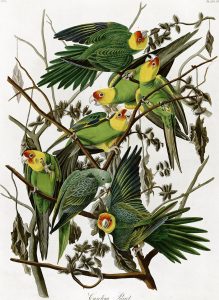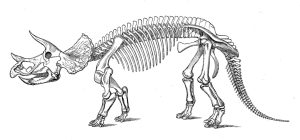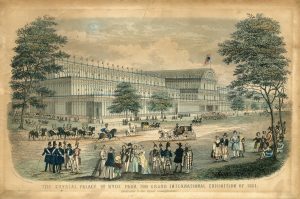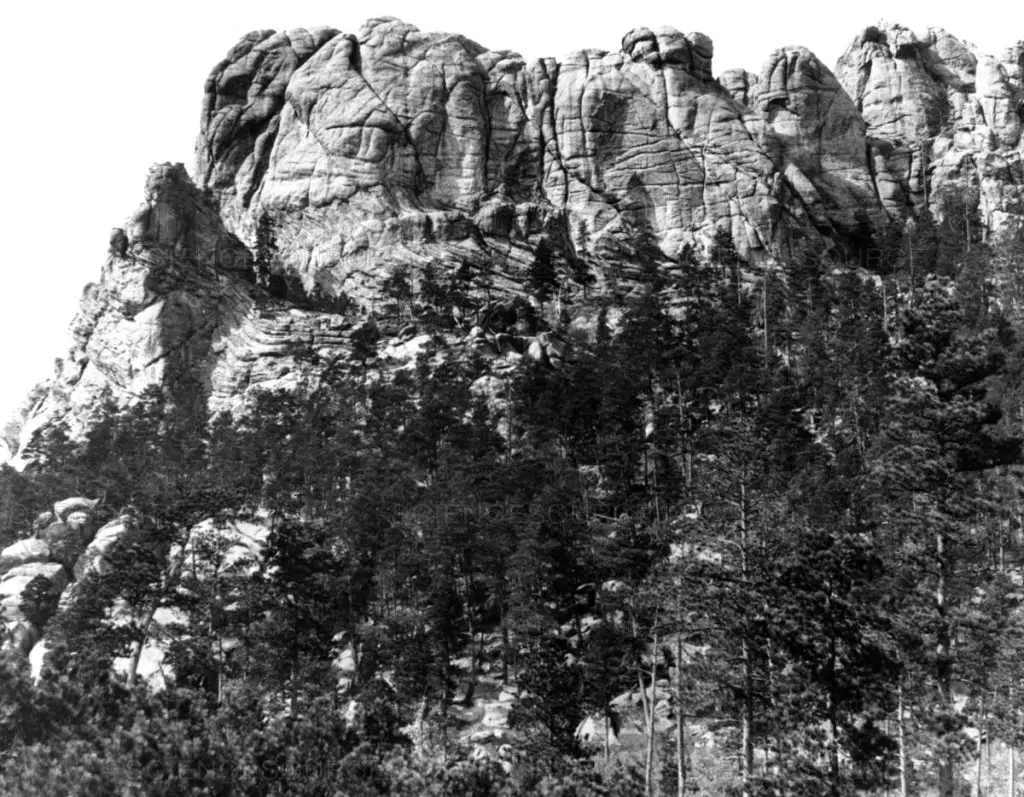
Mount Rushmore (Six Grandfathers) before construction, c. 1905 (Wiki Image).
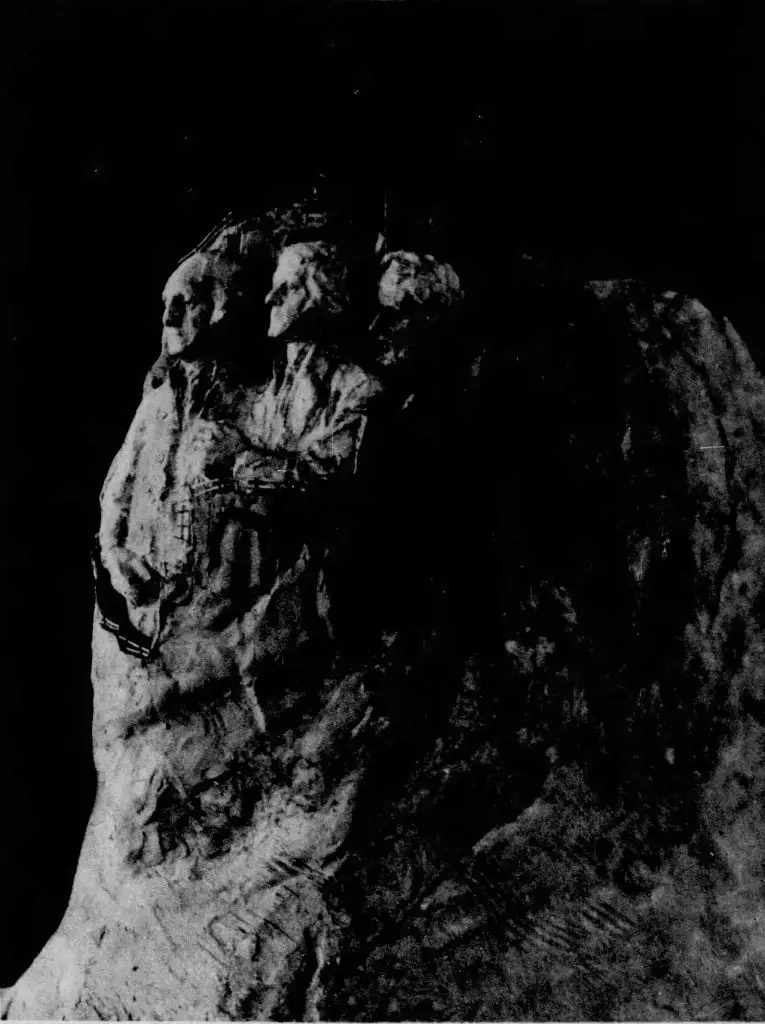
An early model of the design (Wiki Image).
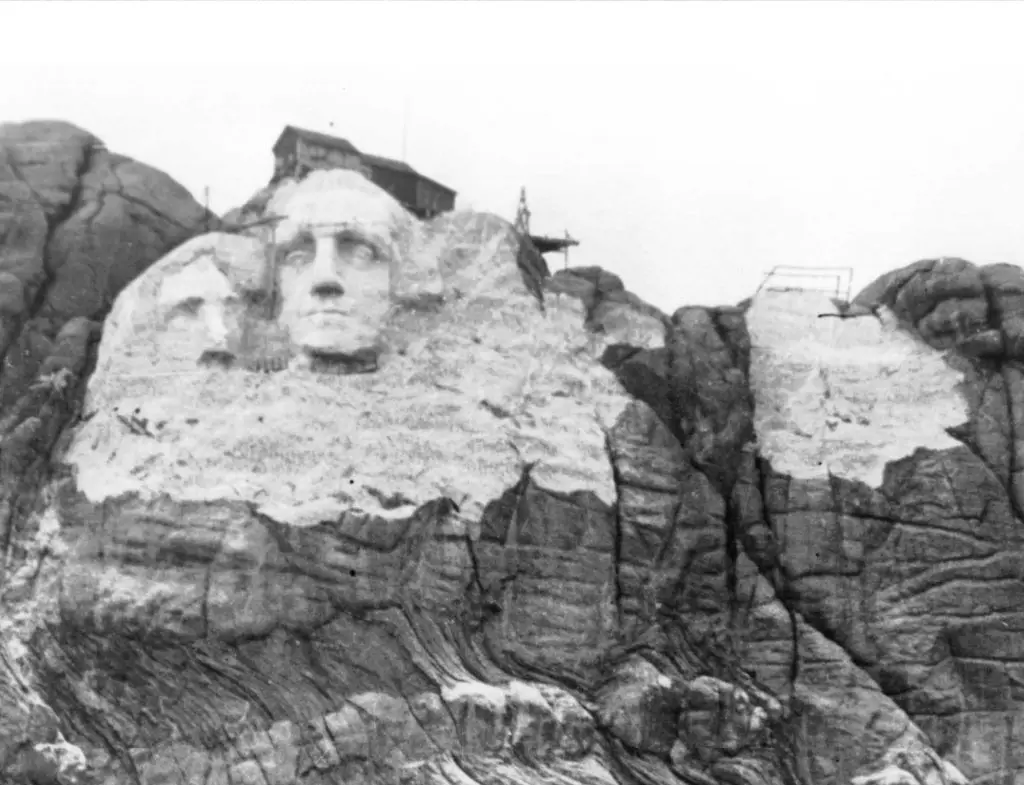
Construction was underway, with Jefferson to the left of Washington before unstable rock necessitated a change in the design (Wiki Image).
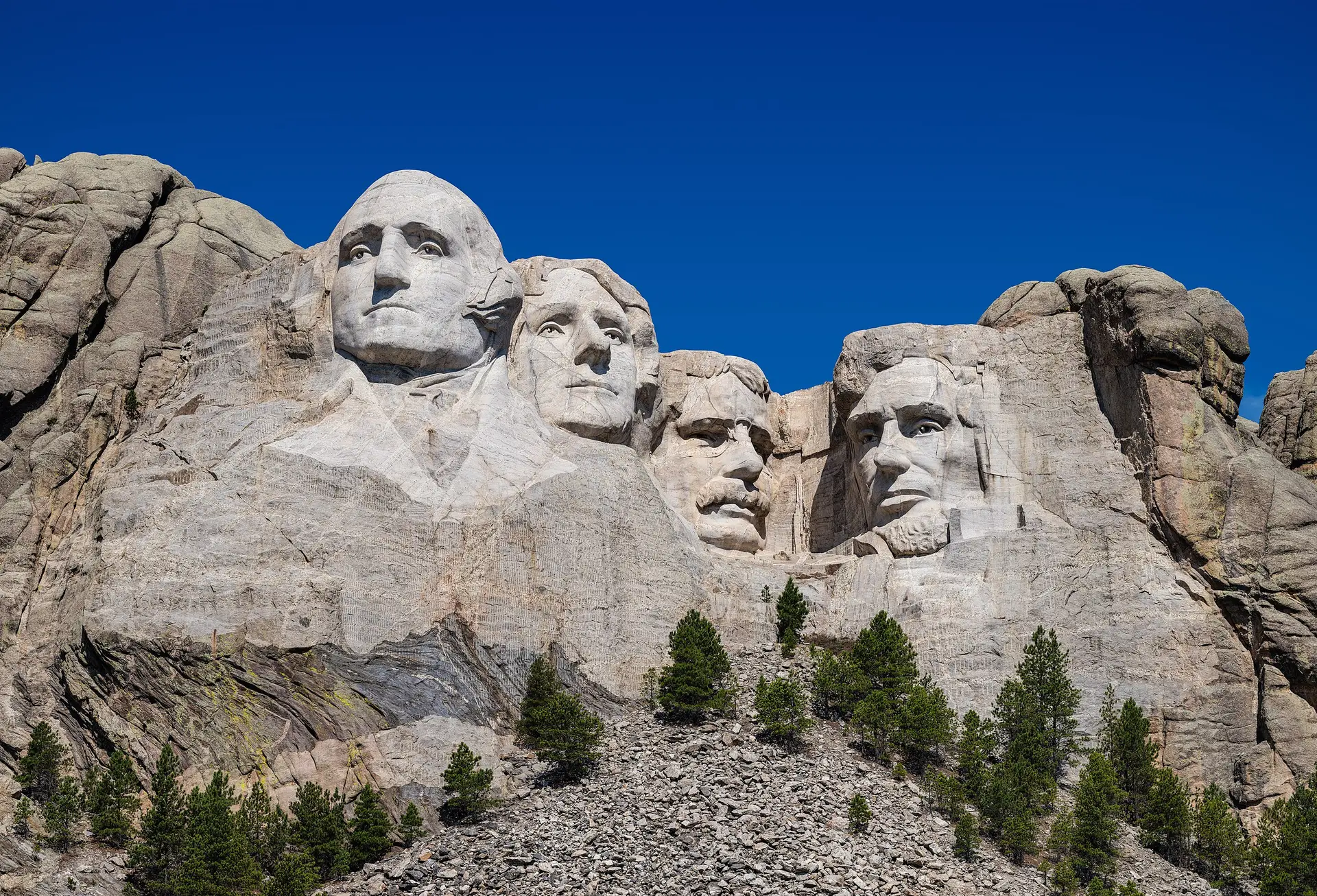
Mount Rushmore features Gutzon Borglum‘s sculpted heads of George Washington, Thomas Jefferson, Theodore Roosevelt, and Abraham Lincoln (left to right) (Wiki Image).
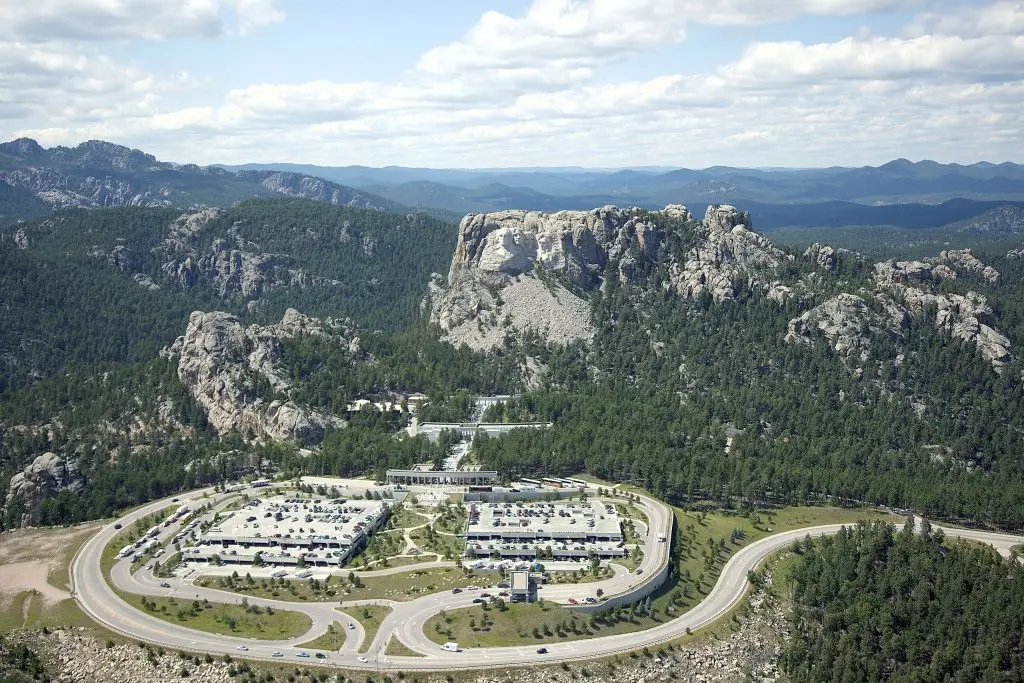
Aerial view of Mount Rushmore and buildings (Wiki Image).
George Washington, Thomas Jefferson, Theodore Roosevelt, and Abraham Lincoln: Mount Rushmore
Ultimate One-Day Mount Rushmore Travel Guide | Mount …
(YouTube video)
The Carving of Mount Rushmore and the Story Behind It
(YouTube video)
Mount Rushmore, located in the Black Hills of South Dakota, features the carved faces of four iconic U.S. presidents: George Washington, Thomas Jefferson, Theodore Roosevelt, and Abraham Lincoln. Each president was chosen for their significant contributions to American history.
George Washington
- Role: First President of the United States
- Presidency: 1789-1797
- Major Achievements:
- Led the Continental Army to victory in the American Revolutionary War.
- Presided over the Constitutional Convention in 1787.
- Established many protocols of the new government, including the cabinet system.
- Symbolism on Mount Rushmore: Represents the birth of the United States.
- Legacy: Known as the “Father of His Country,” Washington set many precedents for the national government and the presidency.
Thomas Jefferson
- Role: Third President of the United States
- Presidency: 1801-1809
- Major Achievements:
- Principal author of the Declaration of Independence.
- Facilitated the Louisiana Purchase in 1803, which doubled the size of the United States.
- Commissioned the Lewis and Clark Expedition.
- Symbolism on Mount Rushmore: Represents the growth of the United States.
- Legacy: Jefferson is remembered for his advocacy for democracy, individual rights, and education. However, his legacy is complicated by his ownership of slaves and his views on slavery.
Theodore Roosevelt
- Role: 26th President of the United States
- Presidency: 1901-1909
- Major Achievements:
- He is known for his progressive policies, including trust-busting and labor reforms.
- Instrumental in the construction of the Panama Canal.
- Advocated for the conservation of natural resources and established numerous national parks, forests, and monuments.
- Symbolism on Mount Rushmore: Represents the development of the United States.
- Legacy: Roosevelt’s energetic personality and wide-ranging reforms significantly shaped the modern presidency and American society.
Abraham Lincoln
- Role: 16th President of the United States
- Presidency: 1861-1865
- Major Achievements:
- Led the country through the Civil War, preserving the Union.
- Issued the Emancipation Proclamation, which began the process of freedom for America’s slaves.
- Delivered the Gettysburg Address, one of the most famous speeches in American history.
- Symbolism on Mount Rushmore: Represents the preservation of the United States.
- Legacy: Lincoln is revered for his leadership during the Civil War and his efforts to end slavery. His legacy is celebrated for his commitment to equality and national unity.
Mount Rushmore Concept
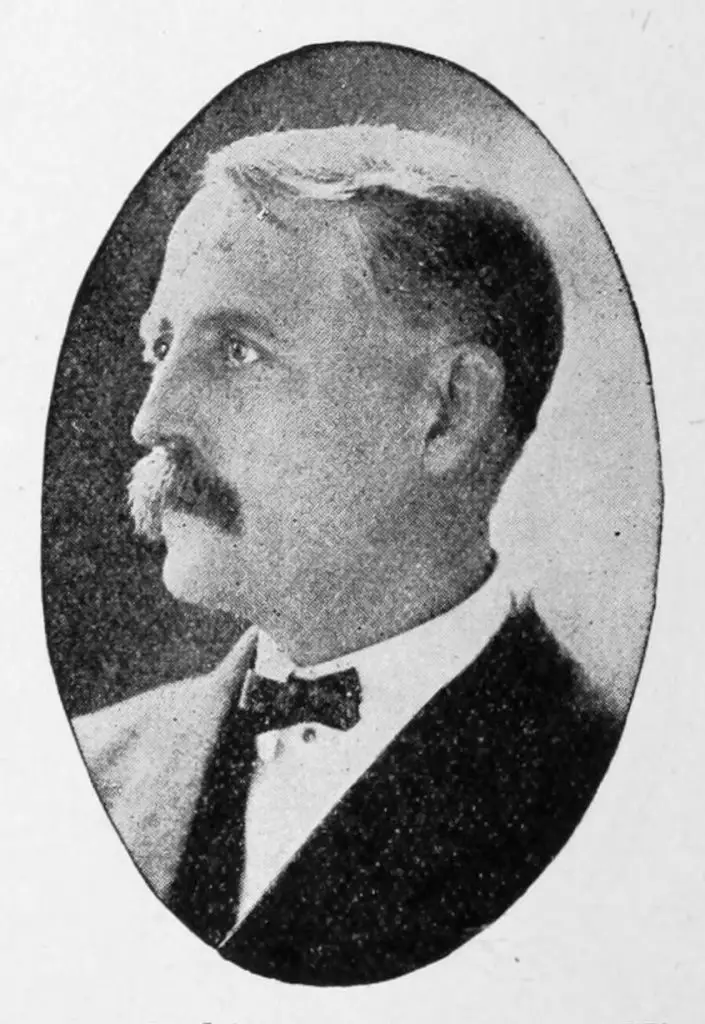
Doane Robinson c. 1915 (Wiki Image).
Doane Robinson: 5 Quote
- On the Concept of Mount Rushmore:
- “We want to attract people from all over America to come and see our country.”
- On the Importance of History:
- “A nation’s history is its greatest treasure. It must be preserved and celebrated for future generations to understand their heritage.”
- On the Significance of Monuments:
- “Monuments are a way of inscribing our history onto the landscape. They tell the story of who we are and where we come from.”
- On Promoting Tourism in South Dakota:
- “The idea of Mount Rushmore is to create a draw that will bring tourists from far and wide to experience the natural beauty and history of the Black Hills.”
- On the Vision for Mount Rushmore:
- “The faces carved into Mount Rushmore will symbolize the foundation, expansion, preservation, and unification of the United States. This monument will stand as a testament to the enduring spirit of our nation.”
Origin and Inspiration:
- Doane Robinson: Known as the “Father of Mount Rushmore,” South Dakota historian Doane Robinson conceived the idea in the early 1920s. His initial concept was to create a monument promoting tourism and celebrating the American West by carving notable figures, such as Western heroes, into the Black Hills.
Evolution of the Idea:
- Selection of Figures: Robinson’s original idea included Lewis and Clark, Sacagawea, and Buffalo Bill Cody. However, Gutzon Borglum, the sculptor chosen for the project, envisioned something more grand and nationally significant. He proposed focusing on four presidents who played pivotal roles in American history.
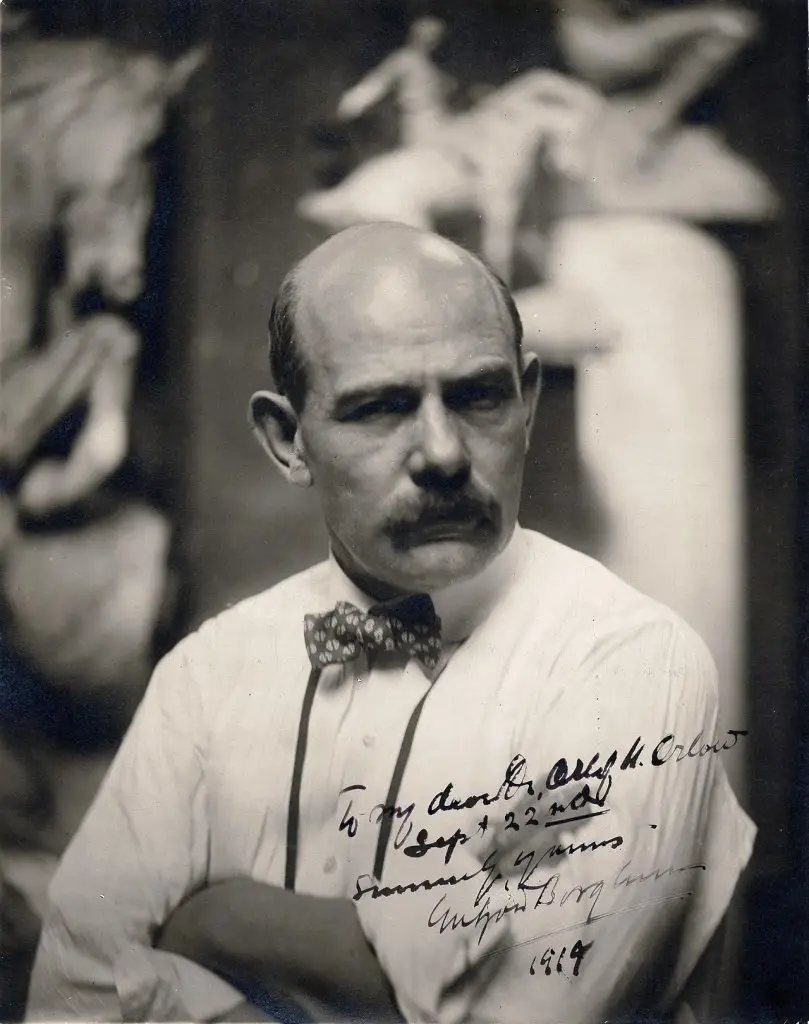
Gutzon Borglum, the sculptor of the memorial (Wiki Image).
Gutzon Borglum: 5 Quotes
- On the Purpose of Mount Rushmore:
- “A monument’s dimensions should be determined by the importance of the events commemorated to civilization.”
- On the Vision for the Monument:
- “Let us place there, carved high, as close to heaven as we can, the words of our leaders, their faces, to show posterity what manner of men they were.”
- On American History:
- “American history shall march along that skyline.”
- On Artistic Legacy:
- “My mark will be left not for what I have done but for what I have chosen to carve into the face of eternity.”
- On the Challenge of Creating Mount Rushmore:
- “A monument that endures is one that represents the ideals and aspirations of a people, captured in stone for future generations to see and reflect upon.”
Gutzon Borglum’s Vision:
- Sculptor’s Influence: Borglum aimed to create a “Shrine of Democracy” that would symbolize the ideals and history of the United States. His vision was to carve four presidents’ faces into Mount Rushmore’s granite face to represent different aspects of the nation’s founding, expansion, development, and preservation.
Selection of Presidents:
- Criteria: Borglum selected the four presidents based on their significant contributions to the United States:
- George Washington: Symbolizing the nation’s birth, Washington led the country to independence and set many presidential precedents.
- Thomas Jefferson: Representing the nation’s growth, Jefferson authored the Declaration of Independence and facilitated the Louisiana Purchase, doubling the size of the United States.
- Theodore Roosevelt: Embodying the nation’s development, Roosevelt’s progressive policies, trust-busting, and conservation efforts significantly shaped modern America.
- Abraham Lincoln: Signifying the preservation of the nation, Lincoln led the country through the Civil War and worked to end slavery, ensuring the survival of the Union.
Construction and Execution:
- Location: Mount Rushmore was chosen for its solid granite composition and prominence in the Black Hills of South Dakota, a site sacred to the Lakota Sioux.
- Funding: The project was financed through federal and private funds, with significant support from Presidents Calvin Coolidge and Franklin D. Roosevelt.
- Engineering Feat: The construction began on October 4, 1927, using dynamite, drills, and chisels. Borglum and his team faced numerous challenges, including harsh weather, funding issues, and the Great Depression.
Dedication and Completion:
- Dedication Ceremonies: Each of the four faces was dedicated separately as they were completed:
- Washington: Dedicated on July 4, 1930
- Jefferson: Dedicated on August 30, 1936
- Lincoln: Dedicated on September 17, 1937
- Roosevelt: Dedicated on July 2, 1939
- Final Work: Although Borglum passed away in March 1941, his son Lincoln Borglum oversaw the completion of the project. The monument was declared finished on October 31, 1941.
Legacy:
- National Symbol: Mount Rushmore has become a symbol of American ideals and history, attracting millions of visitors annually. It represents the country’s founding principles, expansion, development, and preservation.
- Cultural Impact: The monument stands as a testament to the vision and determination of its creators and the enduring legacy of the four presidents immortalized in stone.
Lakota Sioux and Mount Rushmore. Sitting Bull, Crazy Horse, and Custer. In 1980, the U.S. Supreme Court ruled in United States v. Sioux Nation of Indians that the Black Hills were stolen.
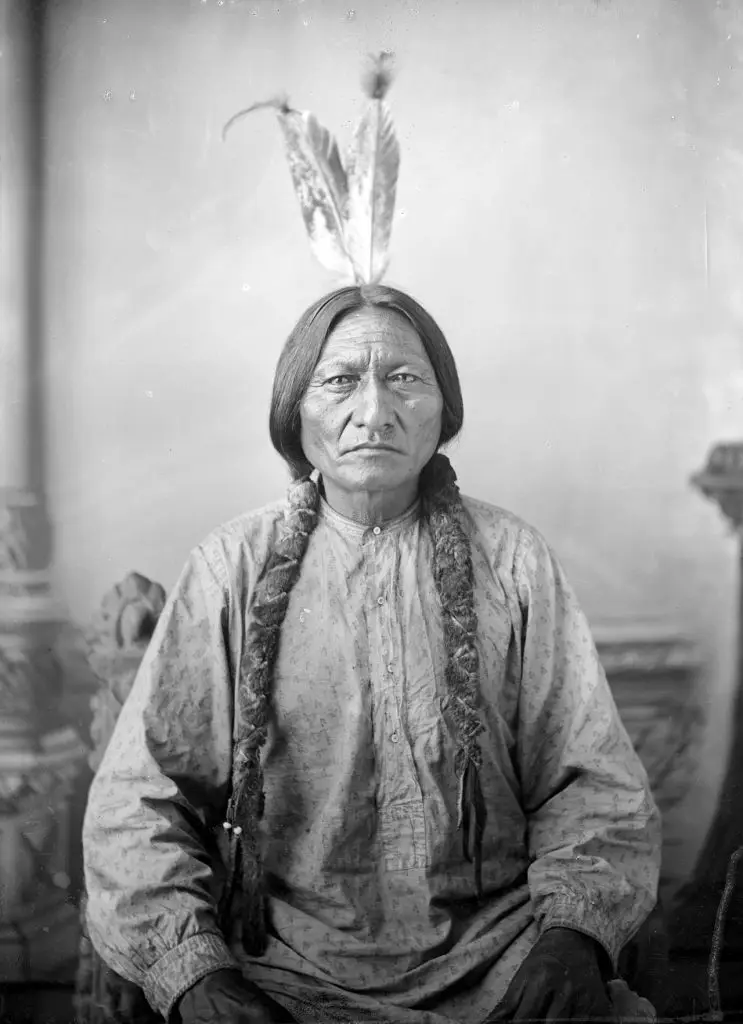 Sitting Bull, c. 1883 (Wiki Image).
Sitting Bull, c. 1883 (Wiki Image).
The history of the Lakota Sioux and Mount Rushmore is deeply intertwined with the story of land theft, cultural conflict, and Native resistance. The Black Hills, known as Paha Sapa to the Lakota, are considered sacred, a place of immense spiritual and cultural importance. The Lakota people were guaranteed ownership of the Black Hills through the 1868 Treaty of Fort Laramie, which established the region as part of the Great Sioux Reservation. However, the discovery of gold in the Black Hills in the 1870s led the U.S. government to break the treaty, seize the land, and open it for settlement. This act marked the beginning of a long history of dispossession and struggle for the Lakota, with Mount Rushmore symbolizing that injustice.
Two of the most significant figures in Lakota resistance during this period were Sitting Bull and Crazy Horse. Sitting Bull, a Hunkpapa Lakota chief, was both a spiritual leader and a symbol of defiance against U.S. expansion into the Great Plains. He is best known for his leadership during the Battle of the Little Bighorn in 1876, where an alliance of Lakota, Cheyenne, and Arapaho warriors defeated General George Armstrong Custer’s 7th Cavalry. This victory, although brief in its impact, became legendary and a significant moment of Native resistance to the U.S. government’s aggressive westward expansion.
Crazy Horse, an Oglala Lakota warrior, played a vital role in the Battle of the Little Bighorn. Known for his fierce dedication to preserving his people’s way of life, Crazy Horse led the Lakota warriors into battle against Custer’s forces, contributing to the total defeat of the U.S. troops. Crazy Horse, like Sitting Bull, became a symbol of Native American resistance and pride. However, both men would ultimately face tragic ends—Crazy Horse was killed in 1877 under disputed circumstances while under arrest, and Sitting Bull was killed in 1890 during a standoff with Indian agency police attempting to suppress the Ghost Dance movement.
The construction of Mount Rushmore, which began in 1927 and was completed in 1941, added another layer of historical grievance for the Lakota people. The monument, featuring the faces of four U.S. presidents—George Washington, Thomas Jefferson, Abraham Lincoln, and Theodore Roosevelt—was carved into the sacred Black Hills, an act that the Lakota viewed as a desecration of their spiritual land. The monument’s sculptor, Gutzon Borglum, selected the presidents to symbolize the nation’s growth and democracy. Still, for the Lakota Sioux, the carving represented the very leaders who oversaw and implemented policies that contributed to Native dispossession.
In response to Mount Rushmore, a movement began 1948 to create the Crazy Horse Memorial, a counter-monument to honor Native American history. Still under construction, this project aims to carve Crazy Horse’s likeness into a nearby mountain as a tribute to the Lakota leader and a symbol of Native resilience. The Crazy Horse Memorial, initiated by Lakota elder Henry Standing Bear and sculptor Korczak Ziolkowski, serves as a counterpoint to Mount Rushmore’s narrative of U.S. power, honoring the resistance and survival of Native cultures in the face of colonial expansion.
A critical moment in the ongoing struggle for justice came in 1980 when the U.S. Supreme Court ruled in United States v. Sioux Nation of Indians that the Black Hills had been wrongfully taken from the Lakota in violation of the 1868 treaty. The court awarded the Sioux monetary compensation for the land, which they refused, instead insisting on the return of the Black Hills. For the Lakota, no amount of money can compensate for losing their sacred land. The refusal of the financial settlement remains a powerful statement of the Lakota’s commitment to reclaiming their ancestral homeland.
The legacy of Sitting Bull, Crazy Horse, and the Lakota people continues to symbolize Native resistance to U.S. colonization. The battle over the Black Hills, Mount Rushmore, and the Supreme Court decision reflects the larger struggle for Native American rights, recognition, and sovereignty. The tensions between Mount Rushmore, glorifying U.S. presidents, and the Crazy Horse Memorial, which honors a Native warrior, encapsulate the historical conflict over land, identity, and cultural survival. The Black Hills remain at the heart of this conflict, representing both a site of loss and a symbol of ongoing resistance.
Crazy Horse Memorial History and Future New Technology
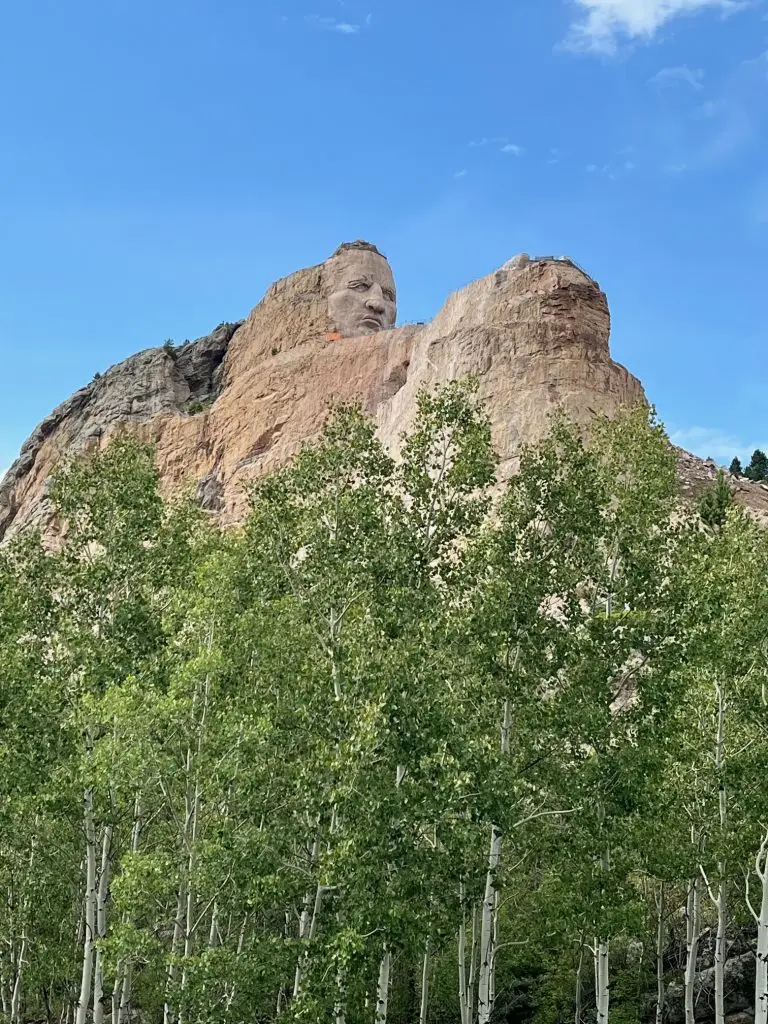 The Crazy Horse Memorial in September 2024 (Black Hills) (personal image).
The Crazy Horse Memorial in September 2024 (Black Hills) (personal image).
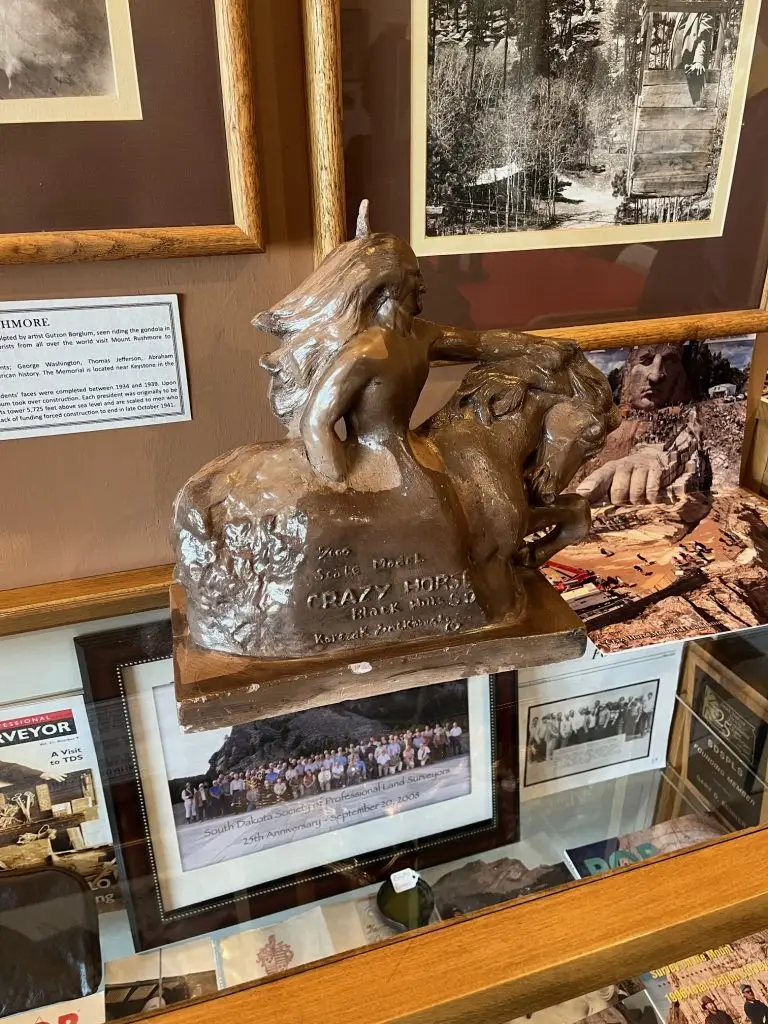
The Crazy Horse Model in September 2024 (personal image).
The Crazy Horse Memorial, located in the Black Hills of South Dakota, was initiated in 1948 to honor the Lakota warrior Crazy Horse and commemorate Native American history, culture, and resistance. The idea came from Lakota Chief Henry Standing Bear, who, in response to the construction of Mount Rushmore, believed that Native Americans needed a monument to represent their heroes and legacy. He chose Korczak Ziolkowski, a Polish-American sculptor, to create a massive tribute to Crazy Horse, the fearless leader who resisted U.S. forces during the 19th century.
Crazy Horse is remembered for his bravery, particularly in the Battle of the Little Bighorn in 1876, where he and other Native warriors defeated General Custer’s forces. His enduring legacy as a protector of his people and their lands and his refusal to be photographed made him a fitting figure for the memorial. The sculpture was designed to be the most prominent mountain carving in the world, portraying Crazy Horse riding a horse and pointing towards his ancestral lands. However, the immense scale and complexity of the project meant that progress has been slow. The work has continued for over 75 years, primarily funded through private donations. Ziolkowski and later his family refused federal funds to keep the project independent and under Native control.
Korczak Ziolkowski began work in 1948, and though he passed away in 1982, his wife, Ruth Ziolkowski, and their children continued the project. The face of Crazy Horse was completed and unveiled in 1998, marking a significant milestone in the monument’s progress. Despite the challenges posed by the sheer size of the project, including its massive scale (Crazy Horse’s head alone is 87 feet tall, compared to Mount Rushmore’s 60-foot-tall heads), work continues today, with efforts focused on sculpting the horse’s head and Crazy Horse’s arm.
In addition to the memorial, the site has become a center for Native American culture and education, including the Indian Museum of North America and the Native American Cultural Center. These institutions promote understanding and appreciation of Native American history, art, and culture. The memorial also hosts events like the Crazy Horse Volksmarch, an annual hike that allows visitors to trek to the top of the mountain carving.
Future Technology and Advancements:
The future of the Crazy Horse Memorial is poised to integrate new technologies to accelerate the sculpting process and enhance the visitor experience. Advances in laser mapping and 3D scanning technology may be used to plan and execute more precise carving, ensuring accuracy in rendering the intricate details of Crazy Horse and his horse. These technologies could also reduce the need for manual, labor-intensive processes, speeding up construction.
Additionally, augmented reality (AR) and virtual reality (VR) technologies could provide visitors with immersive experiences. They could “see” what the finished memorial will look like or learn about the history and culture of Native American tribes through interactive exhibits. Drone technology may also assist in providing aerial views and monitoring the progress of the carving from angles that are difficult to reach using traditional methods.
As the Crazy Horse Memorial progresses, its blend of historical significance and modern technological innovation ensures that it will continue to serve as a tribute to Native American resilience and a symbol of evolving methods in monumental sculpture creation.
Gutzon Borglum History
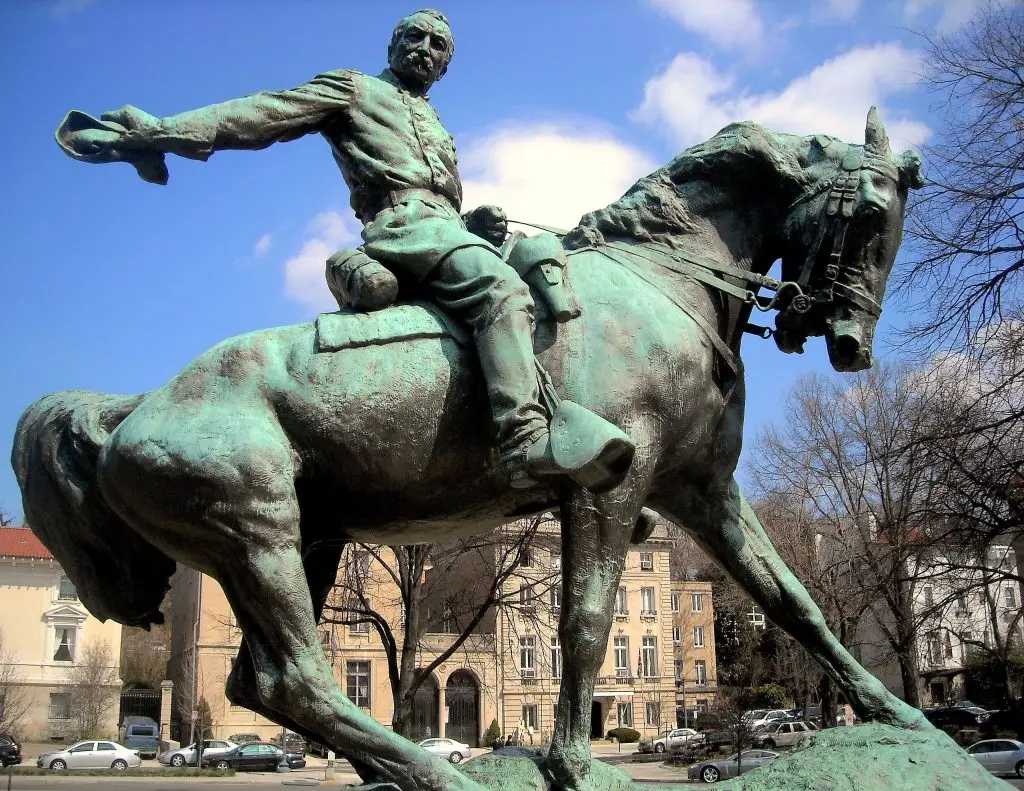 General Philip Sheridan, sculpted by Borglum in 1908 in Washington, D.C. (Wiki Image).
General Philip Sheridan, sculpted by Borglum in 1908 in Washington, D.C. (Wiki Image).
Gutzon Borglum (1867–1941) was a prominent American sculptor best known for designing and carving the iconic Mount Rushmore National Memorial in South Dakota. His work and life were deeply intertwined with monumental art, patriotism, and sometimes controversy. Borglum was born in Idaho to Danish immigrant parents and grew up in various parts of the western United States. He initially pursued a career as an artist and sculptor, studying art in Europe in the 1890s, where French sculptor Auguste Rodin influenced him.
In the early 20th century, Borglum gained national recognition for his large-scale sculptures. He was fascinated by the power of monumental art to symbolize national ideals. His work often focused on American themes, blending a sense of grandeur with political symbolism. His most famous early commission was a giant equestrian statue of General Philip Sheridan in Washington, D.C., completed in 1908. Borglum’s talent for capturing dynamic motion and emotion in his sculptures earned him many admirers.
Borglum’s first significant large-scale project was the Confederate Memorial Carving at Stone Mountain in Georgia, which he began in 1915. This ambitious project was intended to depict Confederate leaders such as Robert E. Lee, Jefferson Davis, and Stonewall Jackson. However, Borglum’s work on Stone Mountain was cut short due to disputes with the project’s sponsors and his conflicts with local politics and finances. He left the project in 1925, and another sculptor eventually completed it, but Borglum had already gained significant experience working with massive granite faces.
His next and most enduring project was Mount Rushmore, for which he is best known. The idea for the monument came from South Dakota historian Doane Robinson, who hoped to boost tourism to the Black Hills. Borglum proposed the grand vision of carving four U.S. presidents—George Washington, Thomas Jefferson, Theodore Roosevelt, and Abraham Lincoln—into the mountain. The project began in 1927 and was supported by federal funding, with Borglum in charge of design and execution.
Mount Rushmore was a project of monumental scope and technical complexity. Borglum developed innovative techniques to sculpt the granite faces, using dynamite to remove large sections of rock and fine chiseling to create the detailed features of the presidents. The carving progressed slowly, with each president’s head taking years to complete. Though Borglum intended the sculpture to be even larger, including the president’s torsos, financial constraints and his death in 1941 left the project unfinished. His son, Lincoln Borglum, oversaw the completion of the heads after his father’s passing.
Borglum’s vision for Mount Rushmore was deeply tied to his belief in American greatness and the ideals of democracy and leadership. However, he was also a complex and controversial figure. He had associations with the Ku Klux Klan during his time working on the Stone Mountain project, which has cast a shadow on his legacy. Additionally, the carving of Mount Rushmore on land sacred to the Lakota Sioux has long been a source of tension, with many Native American groups viewing the monument as a symbol of U.S. encroachment on indigenous lands.
Despite these controversies, Borglum remains a towering figure in American sculpture, known for his ability to fuse art with nationalistic and historical themes. Mount Rushmore endures as one of the most recognizable and enduring symbols of the United States, and Borglum’s vision continues to inspire awe for its scale, ambition, and technical achievement.
Working on Mount Rushmore
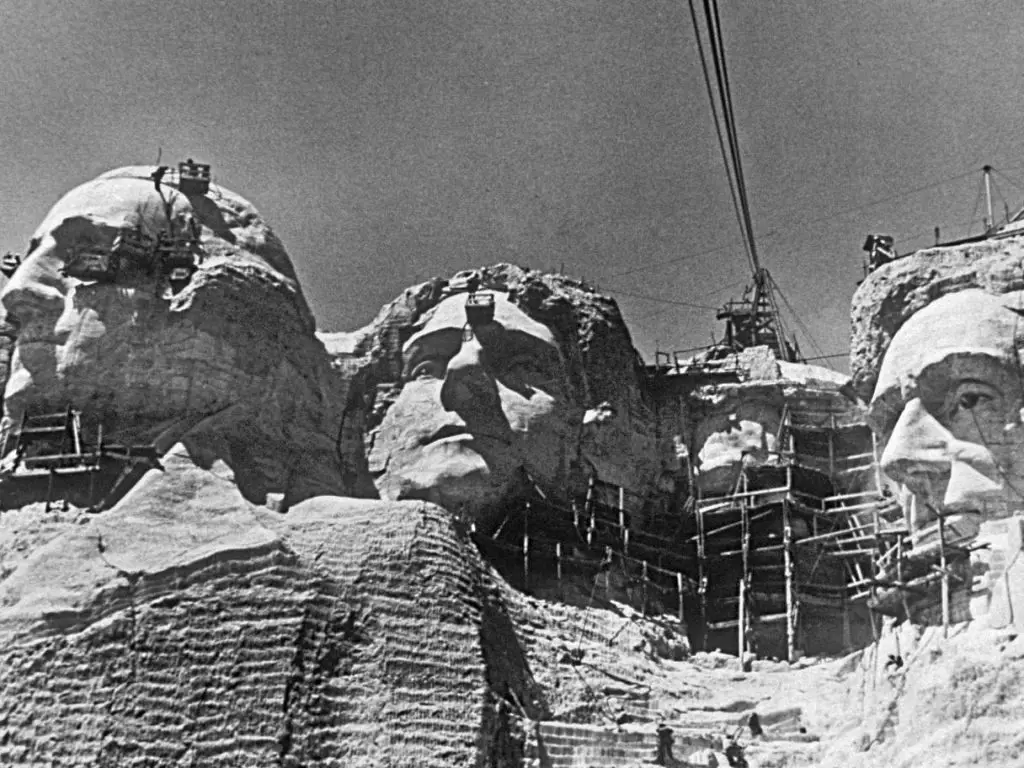
Mount Rushmore (www.travelsouthdakota.com Image)
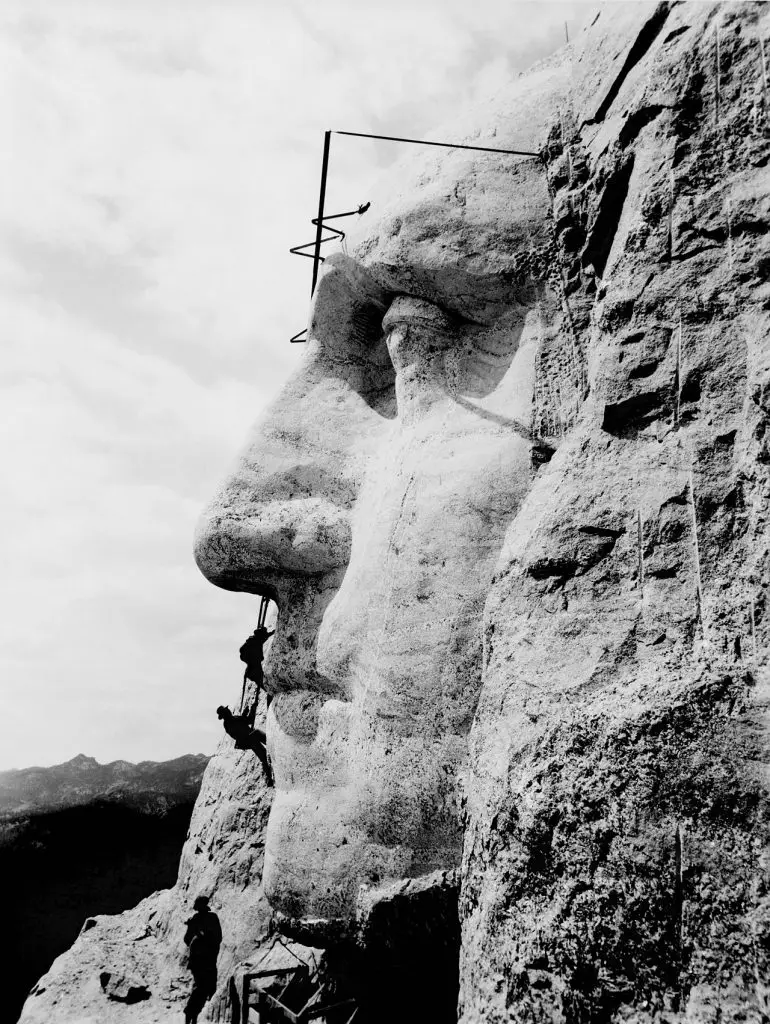 Construction of George Washington’s likeness (Wiki Image).
Construction of George Washington’s likeness (Wiki Image).
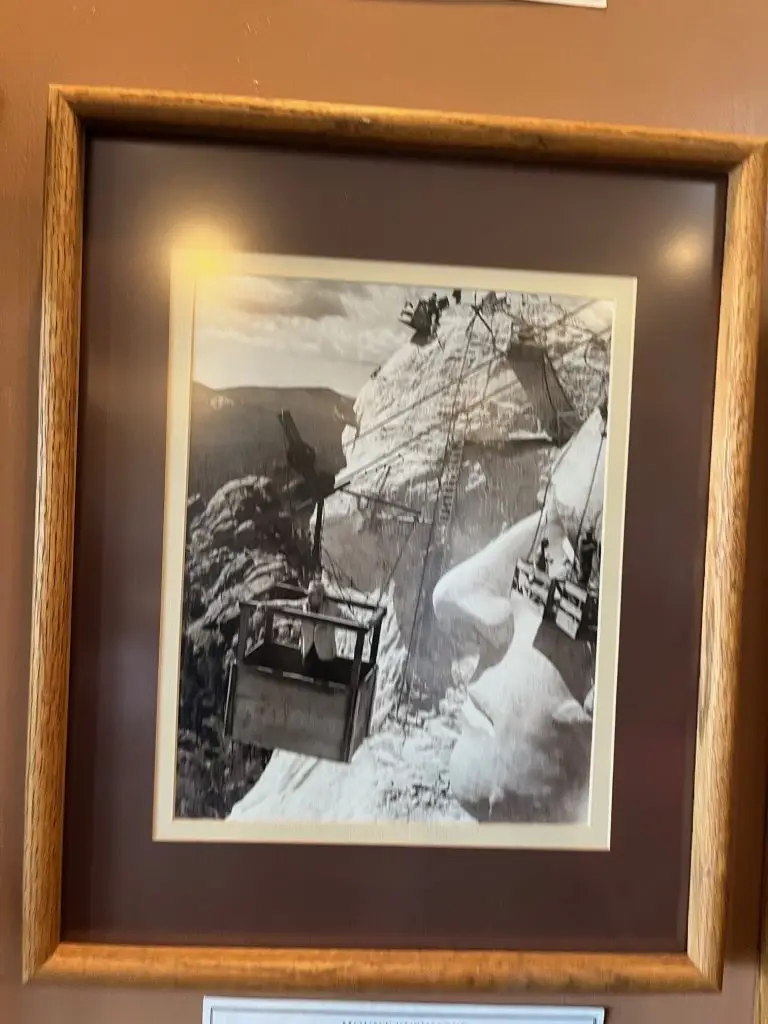 Gutzon Borglum with its trolley and his altimeter (personal image).
Gutzon Borglum with its trolley and his altimeter (personal image).

September 2024 picture (personal image).
How Borglum carved Mount Rushmore | Images of the Past
(YouTube video)
Mount Rushmore is one of the most iconic landmarks in the United States, featuring the 60-foot-high faces of four U.S. presidents: George Washington, Thomas Jefferson, Theodore Roosevelt, and Abraham Lincoln. The monument, located in the Black Hills of South Dakota, was designed and sculpted by Gutzon Borglum. Here’s an overview of how Mount Rushmore was created:
Concept and Planning
- Gutzon Borglum: South Dakota historian Doane Robinson conceived the idea for Mount Rushmore, a monumental attraction in the Black Hills to promote tourism. He initially envisioned carving famous Western figures into the granite cliffs, but Borglum, an accomplished sculptor, proposed instead creating a monument of national significance. Borglum selected the four presidents to represent the founding, growth, development, and preservation of the United States.
- Site Selection: Borglum chose Mount Rushmore (originally known as Six Grandfathers by the Lakota Sioux) for the sculpture due to its granite composition, which would allow for detailed carving, and its southeast-facing location, which would provide optimal sunlight for most of the day.
- Funding and Authorization: Congress authorized the project in 1925, and the federal government and private donations provided funding. However, financial constraints and the onset of the Great Depression made fundraising challenging throughout the project.
Construction Process
- Carving the Faces: The carving of Mount Rushmore began in 1927 and took 14 years to complete, with work continuing until 1941. The process involved several steps:
- Design and Scale Models: Borglum created a scale model of the monument in his studio. The model guided the carving, each inch representing one foot on the mountain.
- Dynamite Blasting: The rough shaping of the mountain was done using dynamite. About 90% of the rock was removed with explosives, making it one of the most significant uses of dynamite in a sculpting project. Workers drilled holes in a honeycomb pattern, and dynamite charges were carefully placed to remove large amounts of rock while preserving the primary form of the faces.
- Precision Work: More precise work was done using pneumatic drills and hand tools after achieving the rough shape. Workers used a process called “pointing,” which involved transferring measurements from the scale model to the mountain using a system of grids and plumb lines.
- Final Details: The final details of the faces, such as the contours of the eyes, nose, and mouth, were meticulously carved using smaller tools. The entire process required both artistic skill and engineering expertise to ensure the faces were accurately depicted and could withstand the elements.
Workers and Safety
- Labor Force: Over 400 workers were employed during the construction of Mount Rushmore. These workers included miners, sculptors, and laborers, many of whom were former miners from the Black Hills. Despite the dangerous working conditions, including the use of explosives and work at high elevations, there were no fatalities during the construction of the monument.
- Safety Measures: Safety harnesses, ropes, and scaffolding protected workers from falls. However, the work was still physically demanding and required precise coordination, particularly during the blasting operations.
Challenges and Completion
- Challenges: The project faced numerous challenges, including financial difficulties, technical problems, and weather conditions. Borglum also had ambitious plans to include more presidents’ bodies and additional inscriptions, but these were never realized due to time and budget constraints.
- Gutzon Borglum’s Death: Gutzon Borglum passed away in March 1941 before the monument was completed. His son, Lincoln Borglum, took over the project and completed the final touches, but the monument was declared finished later that year due to the onset of World War II and the lack of funding.
Mount Rushmore Today
- Preservation: Mount Rushmore is maintained by the National Park Service, which regularly monitors the monument for any signs of wear or damage. Efforts are made to preserve the sculpture’s integrity, including periodic inspections, repairs, and cleaning.
- Tourism: Mount Rushmore attracts over two million visitors annually, making it one of the most popular tourist destinations in the United States. The site includes a visitor center, a museum, and an amphitheater where visitors can learn about the monument’s history and significance.
- Cultural and Historical Significance: While Mount Rushmore is celebrated as a symbol of American history and democracy, its location on land sacred to the Lakota Sioux remains a point of contention. The monument’s construction and impact on Native American heritage continue to be topics of discussion and reflection.
Legacy
Mount Rushmore is both an engineering marvel and a symbol of the complexities of American history. It stands as a testament to the artistic vision and technical skill of Gutzon Borglum and the workers who brought it to life. At the same time, it serves as a reminder of the ongoing dialogue about the nation’s past, particularly concerning the Native American communities whose lands and rights were impacted by its creation.
Money Mount Rushmore
The creation of Mount Rushmore involved significant financial challenges, as the project required substantial funding to cover the costs of labor, materials, and equipment. Here’s a breakdown of the financial aspects of Mount Rushmore:
Initial Funding and Costs
- Estimated Cost: When adjusted for inflation, the cost of constructing Mount Rushmore was approximately $989,992, roughly equivalent to around $18 million in today’s dollars.
- Funding Sources: Mount Rushmore received federal, state, and private funding. South Dakota state historian Doane Robinson initially supported the project, promoting it to boost tourism in the state.
- Federal Funding: The federal government provided a significant portion of the funding. Congress authorized the project and allocated funds through several acts, including the Appropriations Act. The federal government ultimately provided about 85% of the total funding for the project.
- State Funding: The state of South Dakota also contributed to the funding, although its contribution was more modest than federal funding.
- Private Donations: Private fundraising efforts, including donations from individuals and organizations, were organized to support the project. Fundraising was challenging, especially during the Great Depression, but project supporters continued to seek private contributions.
Financial Challenges
- The Great Depression: Construction of Mount Rushmore began in 1927, shortly before the onset of the Great Depression. The economic downturn made fundraising difficult as private and public funding sources became more limited.
- Cost Overruns: As with many large-scale projects, Mount Rushmore’s costs exceeded initial estimates. The project’s complexity and the need for specialized labor and equipment led to higher-than-expected expenses.
- Unfinished Plans: Gutzon Borglum had grander plans for Mount Rushmore, including additional figures and inscriptions that were never completed due to a lack of funds. His original vision included carving more of the presidents’ torsos and adding a “Hall of Records” behind the monument, which was partially started but never finished.
Legacy of Funding
- Tourism Revenue: While constructing Mount Rushmore was a significant financial undertaking, it has since become one of the most popular tourist attractions in the United States, generating considerable revenue for the region. The monument’s popularity has helped to recoup the initial investment through tourism-related income for South Dakota.
- Ongoing Costs: The National Park Service, which manages Mount Rushmore, continues to allocate funds for its maintenance and preservation. These costs include monitoring the integrity of the sculpture, repairing any damage, and ensuring the safety of visitors.
Mount Rushmore is a testament to its creators’ artistic and engineering achievements and the financial challenges of such an ambitious project. Despite the economic difficulties of the time, the combination of federal, state, and private support made completing this American icon possible.
George Washington: Mount Rushmore History
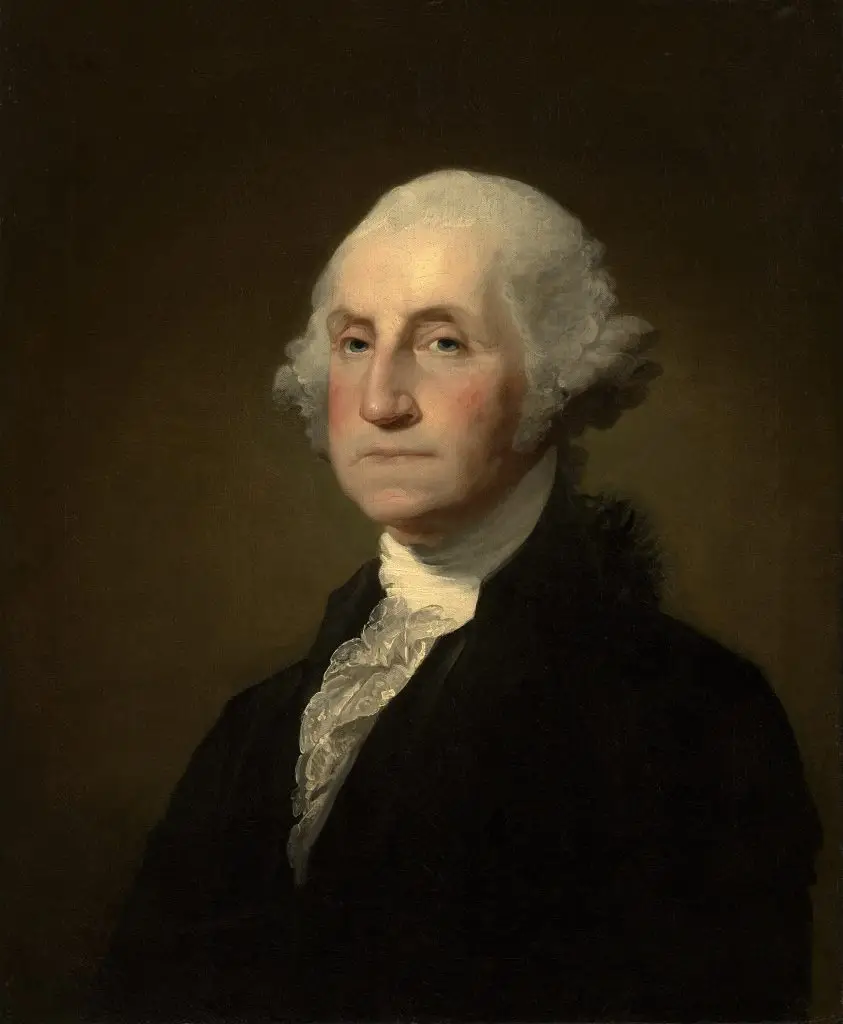
George Washington Portrait c. 1803 (Wiki Image).
Background and Significance:
- Selection for Mount Rushmore: George Washington was chosen to represent the birth of the United States. As the first president and a key figure in the American Revolution, his leadership laid the foundation for the new nation.
- Representation: Washington’s inclusion symbolizes the nation’s independence and the establishment of its democratic government. His legacy as the “Father of His Country” underscores his role in shaping the early United States.
Role and Achievements:
- Commander of the Continental Army: Washington led the American forces to victory against the British during the Revolutionary War, securing American independence.
- First President: As the first President of the United States (1789-1797), Washington set many precedents for the national government and the presidency, including establishing a cabinet system and the tradition of peaceful power transfer.
- Foundational Influence: Washington was crucial in drafting the Constitution and ensuring its ratification. His leadership helped stabilize the fledgling nation and promote unity among the states.
Key Contributions
- Presidential Precedents: Washington’s actions and decisions as president established enduring practices and norms for the office. His leadership style emphasized neutrality in foreign conflicts, which set the tone for American foreign policy for years to come.
- Farewell Address: Washington’s Farewell Address guided future governance, warning against political parties’ divisive effects and advocating for neutrality in international affairs.
Mount Rushmore Construction:
- Sculptor: The monument was designed by sculptor Gutzon Borglum, who chose Washington as one of the four presidents to be featured due to his paramount role in the nation’s founding.
- Construction Timeline: Work on Mount Rushmore began in 1927 and was completed in 1941. Washington’s face was the first to be completed in 1930.
- Challenges: The construction of Mount Rushmore faced numerous challenges, including funding issues, technical difficulties, and the sheer scale of the project. Despite these obstacles, Washington’s likeness was successfully carved into the granite of the Black Hills in South Dakota.
Legacy and Impact:
- Symbol of Leadership: Washington’s presence on Mount Rushmore reminds us of his exemplary leadership and dedication to the principles of democracy and freedom.
- Inspiration for Future Generations: His legacy inspires Americans, symbolizing the country’s enduring values and the importance of strong, principled leadership.
- Tourism and Education: Mount Rushmore attracts millions of visitors annually, educating the public about Washington’s contributions and the historical significance of the United States’ early years.
Conclusion
George Washington’s depiction of Mount Rushmore represents the birth of the United States and honors his pivotal role in the nation’s founding. His achievements as a military leader, first president, and key figure in establishing the principles of American democracy are immortalized in this iconic monument, serving as an enduring symbol of American heritage and values.
George Washington: Mount Rushmore Construction and Dedication.
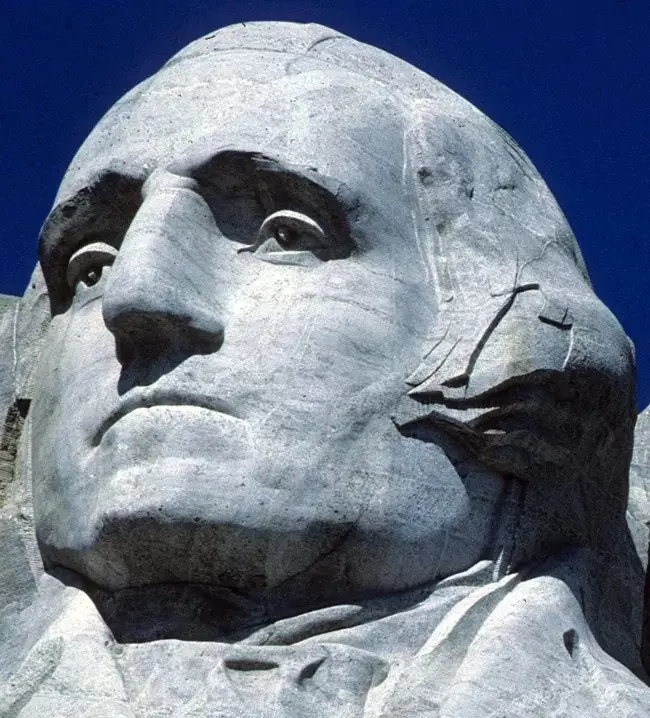
George Washington (https://www.nps.gov/moru/learn/historyculture/why-these-four-presidents.htm).
Construction:
The construction of George Washington’s face on Mount Rushmore was monumental. It marked the beginning of the ambitious project that would span 14 years and involve hundreds of workers. Work commenced on August 10, 1927, under the direction of sculptor Gutzon Borglum.
- Dynamite and Precision: The process involved a unique blend of large-scale demolition and meticulous artistry. Dynamite was used to blast away large sections of granite to rough out the shape of Washington’s head. This was followed by a more delicate process of drilling and chiseling to refine the details of the face, capturing the essence of the first president’s likeness.
- Challenges: The workers, many experienced miners, faced numerous challenges throughout the construction process. Unpredictable weather, harsh conditions, and the sheer scale of the project tested their skills and endurance. They worked tirelessly, often suspending hundreds of feet in the air on precarious scaffolding to bring Borglum’s vision to life.
- Technological Innovation: The project also implemented innovative techniques, such as compressed air drills and specially designed measuring tools, to ensure the accuracy and precision of the carving.
Dedication:
The completion of George Washington’s face was a significant milestone in the creation of Mount Rushmore. On July 4, 1930, a dedication ceremony commemorated the occasion.
- National Celebration: Thousands attended the event, including President Calvin Coolidge, who delivered a speech honoring Washington’s legacy as the “Father of His Country.”
- Symbolism: Washington’s face’s dedication symbolized the nation’s birth and the enduring ideals upon which it was founded. It also served as a testament to the hard work and dedication of the workers who brought the sculpture to life.
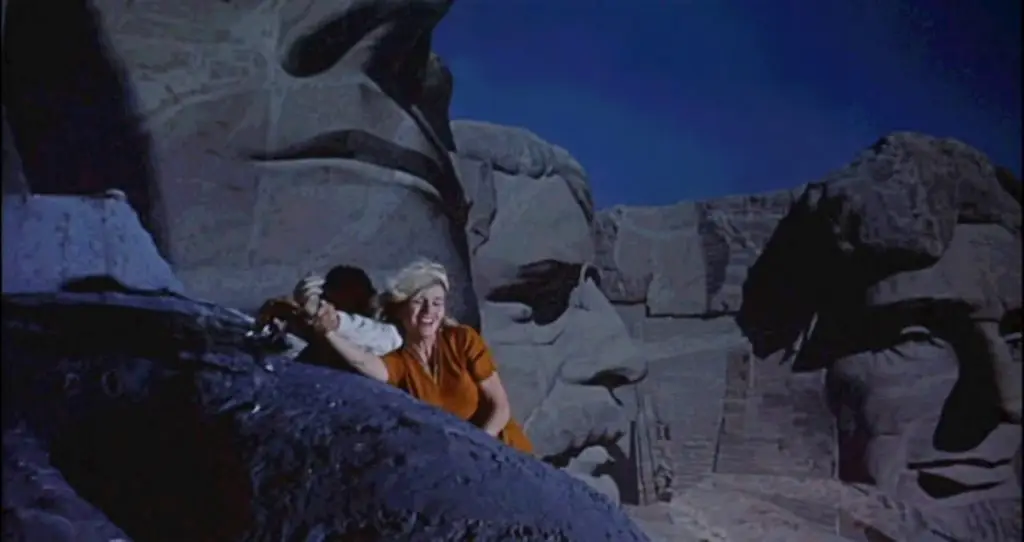 Roger Thornhill (Cary Grant) and Eve Kendall (Eva Marie Saint) dangle precipitously from the sculpture of George Washington in the 1959 film North by Northwest (Wiki Image).
Roger Thornhill (Cary Grant) and Eve Kendall (Eva Marie Saint) dangle precipitously from the sculpture of George Washington in the 1959 film North by Northwest (Wiki Image).
Thomas Jefferson: Mount Rushmore History
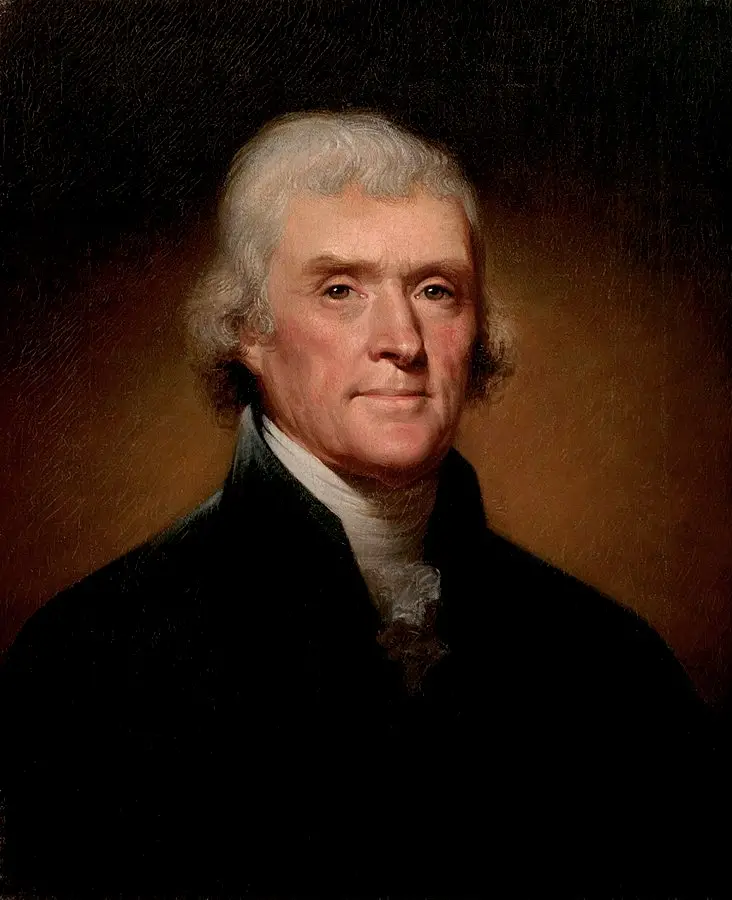
Thomas Jefferson’s 1800 portrait (Wiki Image).
Background and Early Life:
- Born: April 13, 1743
- Place of Birth: Shadwell, Virginia
- Education: Attended the College of William & Mary
- Early Career: Practiced law and served in the Virginia House of Burgesses
Political Career and Presidency:
- Declaration of Independence: Principal author of the Declaration of Independence in 1776.
- Governor of Virginia: Served as Governor of Virginia from 1779 to 1781.
- Secretary of State: First Secretary of State under President George Washington.
- Vice President: Served as Vice President under John Adams from 1797 to 1801.
- President: Third President of the United States from 1801 to 1809.
- Louisiana Purchase: Oversaw the Louisiana Purchase in 1803, doubling the size of the United States.
- Lewis and Clark Expedition: Commissioned the Lewis and Clark Expedition to explore the newly acquired western territory.
Mount Rushmore:
- Concept: The idea for Mount Rushmore was conceived by historian Doane Robinson to promote tourism in South Dakota.
- Selection: Sculptor Gutzon Borglum was chosen to design and execute the project. Borglum selected four presidents to represent different aspects of American history: George Washington, Thomas Jefferson, Theodore Roosevelt, and Abraham Lincoln.
- Symbolism: Jefferson was chosen to symbolize the growth of the United States, mainly through his role in the Louisiana Purchase, which expanded the nation’s territory.
- Construction: Work on Mount Rushmore began in 1927 and continued until 1941. Jefferson’s face was initially intended to be on the right side of Washington, but due to the poor quality of the rock, it was moved to the left.
- Dedication: Jefferson’s face was dedicated on August 30, 1936, at a ceremony President Franklin D. Roosevelt attended.
Legacy:
- Contributions: Jefferson’s contributions to American history are vast, including his authorship of the Declaration of Independence, his role in expanding the United States, and his advocacy for individual liberties and education.
- Controversies: Jefferson’s legacy is also marked by his ownership of slaves and his complex relationship with the institution of slavery, which has prompted ongoing discussions about his place in American history.
- Enduring Influence: Jefferson’s ideas about democracy, education, and individual rights continue influencing American political thought and policy.
Key Points about Jefferson’s Inclusion on Mount Rushmore:
- Representation of Growth: Chosen to symbolize the expansion and growth of the United States.
- Significant Achievements: He was celebrated for his role in the Louisiana Purchase and the exploration of the western territories.
- Dedication Ceremony: His face was the second to be completed and dedicated to the monument.
Mount Rushmore remains a testament to Jefferson’s enduring legacy and his contributions to the foundation and expansion of the United States.
Thomas Jefferson: Mount Rushmore Construction and Dedication.
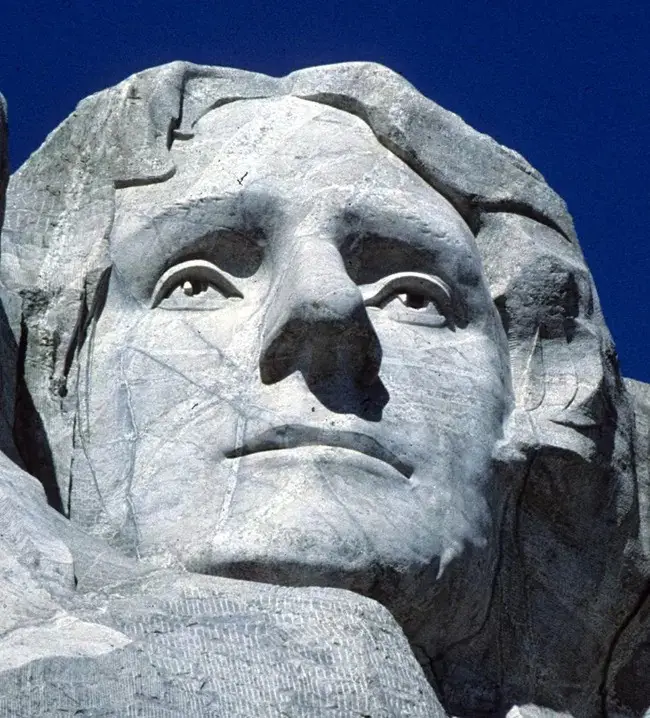
Thomas Jefferson (https://www.nps.gov/moru/learn/historyculture/why-these-four-presidents.htm).
Construction:
- Start Date: Work on Thomas Jefferson’s likeness began in 1936 after George Washington’s face was completed.
- Challenges:
- Relocation: Jefferson’s face was initially started on the right side of Washington, but due to unsuitable rock, the carving was dynamited and moved to the left side of Washington.
- Engineering: The project required precision in measurements and carving techniques. Dynamite removed large rock sections, followed by more detailed carving with drills and chisels.
- Completion: Jefferson’s face was the second to be completed on Mount Rushmore. His likeness was finalized and revealed in 1936.
Dedication:
- Dedication Ceremony:
- Date: The face of Thomas Jefferson was formally dedicated on August 30, 1936.
- Speakers: President Franklin D. Roosevelt attended and gave a speech during the ceremony, highlighting Jefferson’s contributions to the nation’s development and democratic ideals.
- Significance: The dedication emphasized Jefferson’s role in American history, particularly his influence on the nation’s democratic foundations and territorial expansion.
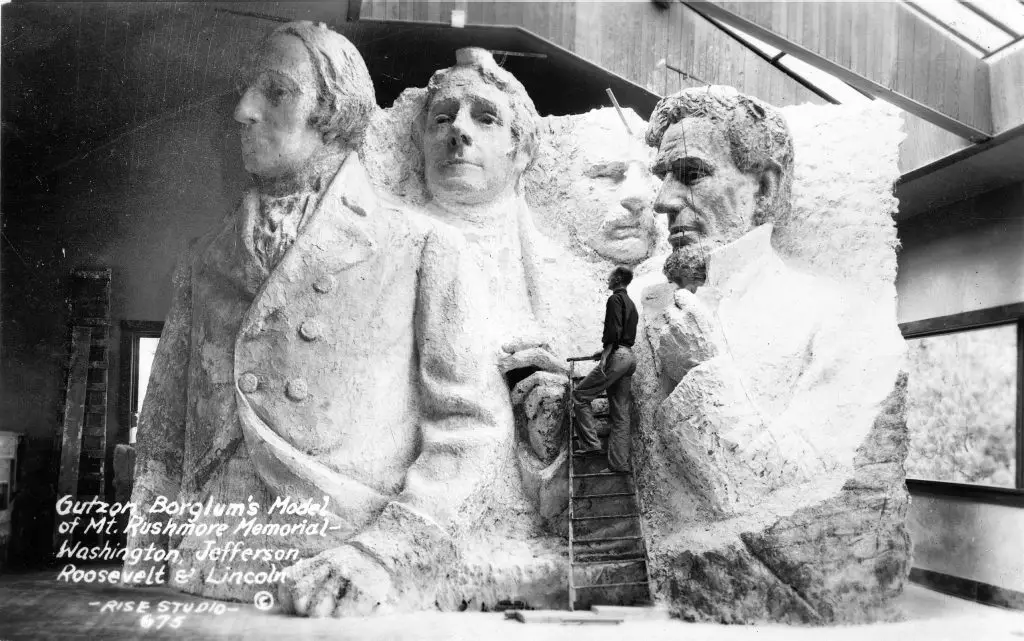 Original mockup of the Mount Rushmore statue “before funding ran out” (Wiki Image).
Original mockup of the Mount Rushmore statue “before funding ran out” (Wiki Image).
Theodore Roosevelt: Mount Rushmore History
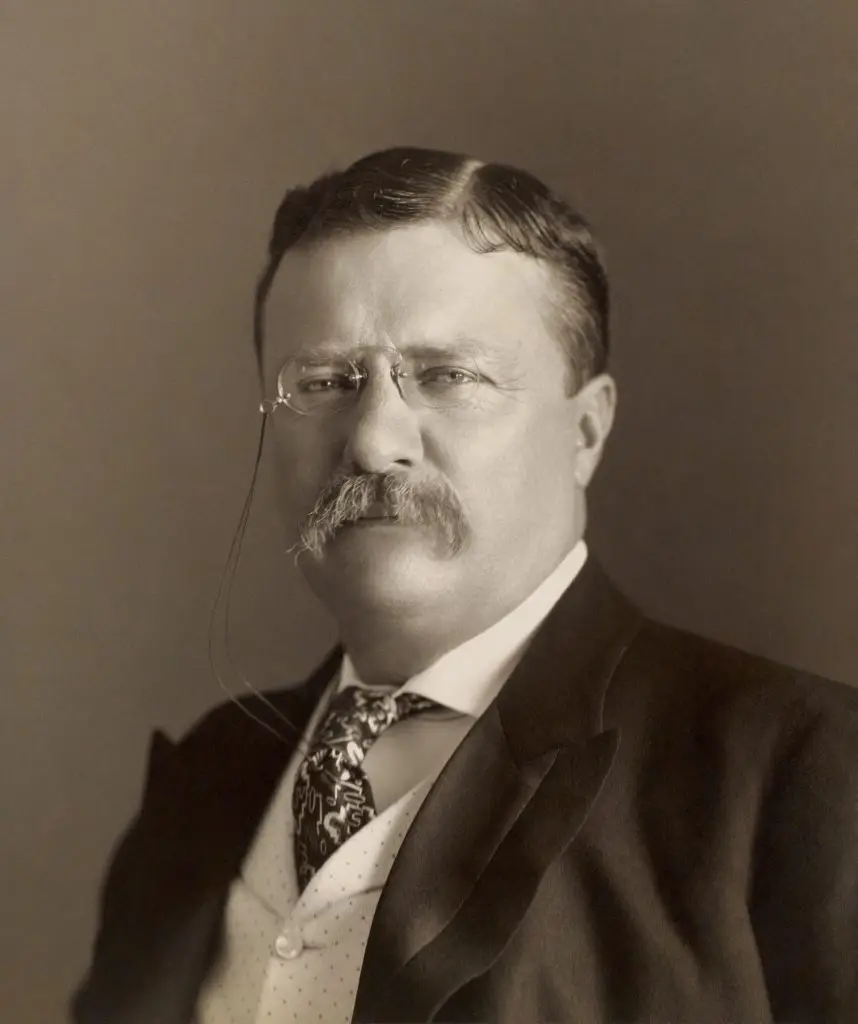
Theodore Roosevelt, c. 1904 (Wiki Image).
Background and Early Life:
- Born: October 27, 1858
- Place of Birth: New York City, New York
- Education: Graduated from Harvard College in 1880
- Early Career: Worked as a rancher, police commissioner, and assistant secretary of the Navy
Political Career and Presidency:
- Governor of New York: Served as Governor of New York from 1899 to 1900.
- Vice President: Became Vice President under President William McKinley in 1901.
- President: Became the 26th President of the United States after McKinley’s assassination in 1901, serving until 1909.
- Major Achievements:
- Progressive Reforms: Implemented progressive policies, including trust-busting, to break up large monopolies and regulate corporations.
- Panama Canal: Instrumental in constructing the Panama Canal, facilitating international maritime trade.
- Conservation Efforts: Advocated for the conservation of natural resources, establishing numerous national parks, forests, and monuments.
- Square Deal: Introduced the Square Deal, focusing on consumer protection, controlling corporations, and conserving natural resources.
- Foreign Policy: He is known for his “Big Stick” diplomacy and the Roosevelt Corollary to the Monroe Doctrine, which asserted U.S. influence in the Western Hemisphere.
Mount Rushmore:
- Concept: The idea for Mount Rushmore was conceived by historian Doane Robinson to promote tourism in South Dakota.
- Selection: Sculptor Gutzon Borglum chose Theodore Roosevelt to represent the development of the United States, highlighting his contributions to the nation’s expansion and modernization.
- Construction: Work on Mount Rushmore began in 1927 and continued until 1941. Roosevelt’s face was the third to be carved on the monument.
- Dedication: Roosevelt’s face was dedicated on July 2, 1939. The dedication ceremony emphasized his role in shaping modern America through his progressive policies and conservation efforts.
Legacy:
- Conservation: Roosevelt’s legacy is strongly associated with the conservation movement. He established the U.S. Forest Service and signed into law the creation of five national parks, 18 national monuments, and 150 national forests.
- Progressive Reforms: His progressive policies laid the groundwork for future reforms in labor rights, consumer protection, and government regulation.
- Modern Presidency: Roosevelt is credited with transforming the presidency into a more dynamic and powerful executive office, using his position to advocate for and implement significant policy changes.
- International Influence: His foreign policy strategies reinforced the United States’ presence on the global stage, particularly in Latin America and the Caribbean.
Key Points about Roosevelt’s Inclusion on Mount Rushmore:
- Representation of Development: Chosen to symbolize the development and modernization of the United States.
- Significant Achievements: He was celebrated for his progressive reforms, conservation efforts, and significant contributions to expanding American influence domestically and internationally.
- Dedication Ceremony: His face was the third to be completed and dedicated on the monument, highlighting his role in shaping the nation’s early 20th-century trajectory.
Mount Rushmore is a testament to Roosevelt’s enduring legacy and significant impact on American history. His contributions to progressive reforms, conservation, and international diplomacy continue to influence the nation and its policies.
Theodore Roosevelt: Mount Rushmore Construction and Dedication.
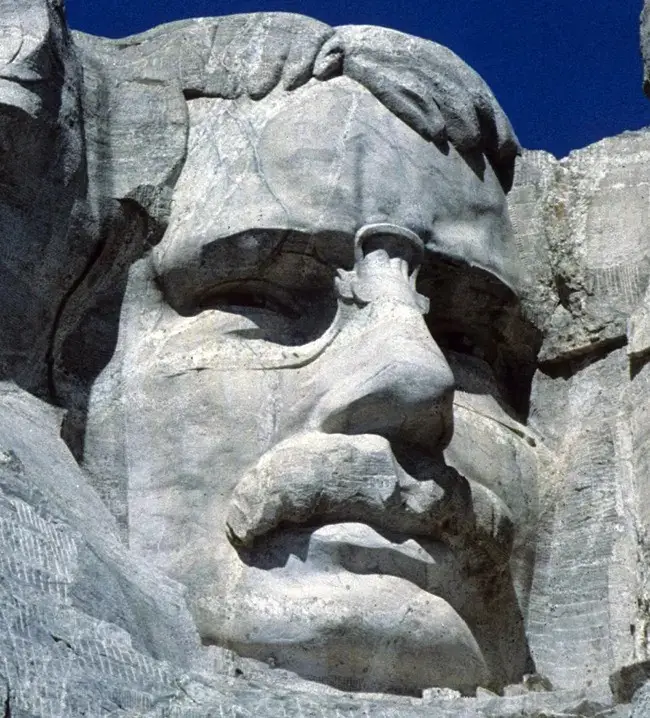
Theodore Roosevelt (https://www.nps.gov/moru/learn/historyculture/why-these-four-presidents.htm).
Construction:
The construction of Theodore Roosevelt’s face on Mount Rushmore was challenging and complex. The original location chosen for Roosevelt’s likeness was to the right of George Washington. However, after months of work, the granite was found to be too fractured and unstable, forcing the team to abandon their efforts and start anew.
A new location was selected to the left of Thomas Jefferson, where the granite was deemed more suitable. However, this new site presented challenges, as the rock was more complex and required more extensive blasting and drilling. The workers, many of whom were miners and experienced in working with dynamite, utilized a combination of blasting, drilling, and chiseling to shape the 60-foot-tall sculpture. The process was slow and meticulous, with workers often suspended hundreds of feet in the air on precarious scaffolding.
Dedication:
Despite the challenges, the carving of Theodore Roosevelt’s face was completed and dedicated on July 2, 1939. A large crowd attended the ceremony, including Roosevelt’s son, Kermit. Speeches highlighted Roosevelt’s contributions to American history, emphasizing his role in conservation, trust-busting, and his efforts to promote peace and stability on the international stage. The event celebrated Roosevelt’s legacy as a dynamic and transformative leader who expanded the United States’ influence on the world stage and championed progressive policies.
The dedication of Roosevelt’s face on Mount Rushmore solidified his place among the most revered figures in American history. It is a testament to his enduring impact on the nation’s development and his commitment to conservation, social justice, and international peace.
Abraham Lincoln: Mount Rushmore History
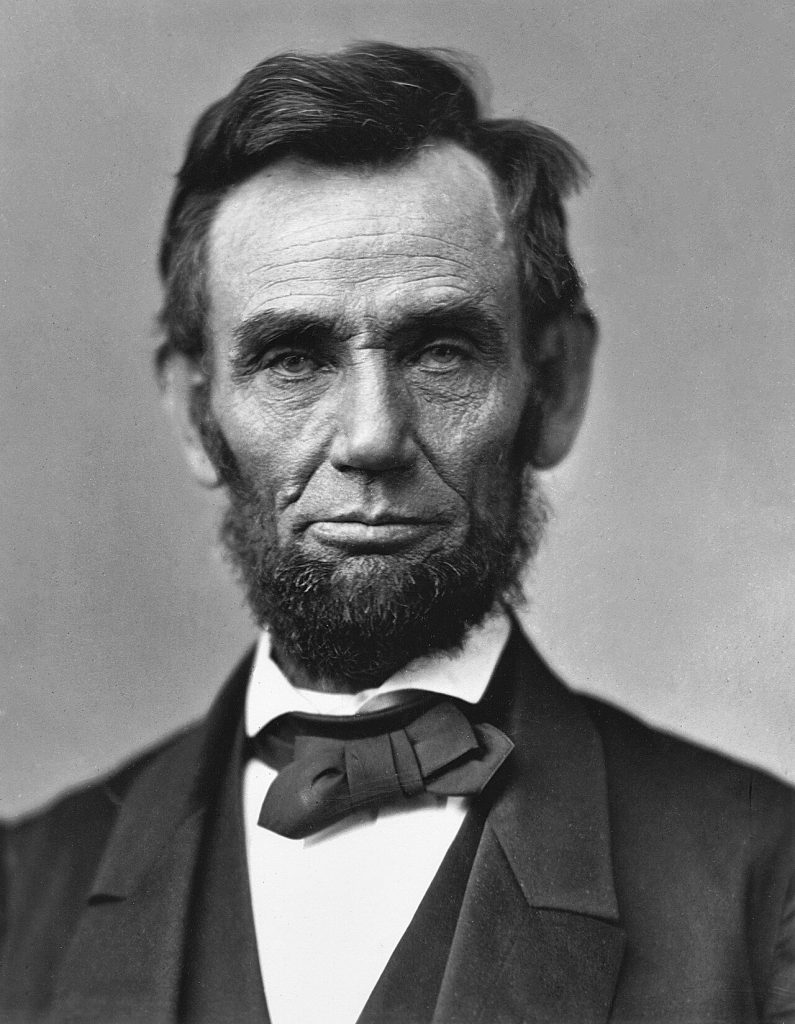
Lincoln in 1863 (Wiki Image).
Background and Early Life:
- Born: February 12, 1809
- Place of Birth: Hardin County (now LaRue County), Kentucky
- Education: Mostly self-educated; briefly attended school
- Early Career: Worked as a lawyer and served in the Illinois State Legislature and the U.S. House of Representatives
Political Career and Presidency:
- 16th President of the United States: Served from March 1861 until his assassination in April 1865.
- Major Achievements:
- Civil War Leadership: Led the country through its greatest internal crisis, the Civil War, preserving the Union.
- Emancipation Proclamation: Issued on January 1, 1863, it declared the freedom of all slaves in Confederate-held territory.
- Gettysburg Address: Delivered on November 19, 1863, it redefined the purpose of the war and is considered one of the greatest speeches in American history.
- 13th Amendment: Played a vital role in the amendment’s passage, which abolished slavery in the United States.
Mount Rushmore:
- Concept: The idea for Mount Rushmore was conceived by historian Doane Robinson to promote tourism in South Dakota.
- Selection: Sculptor Gutzon Borglum chose Abraham Lincoln to represent the preservation of the United States, highlighting his role in maintaining the Union during the Civil War.
- Construction: Work on Mount Rushmore began in 1927 and continued until 1941. Lincoln’s face was the fourth and final carved on the monument.
- Dedication: Lincoln’s face was dedicated on September 17, 1937. The dedication ceremony emphasized his role in preserving the nation and his contributions to ending slavery.
Legacy:
- Civil War: Lincoln’s leadership during the Civil War is one of his most enduring legacies. His ability to navigate the Union through its darkest hours has cemented his place as one of America’s greatest presidents.
- Emancipation: His efforts to end slavery, culminating in the Emancipation Proclamation and the passage of the 13th Amendment, have had a profound and lasting impact on American society.
- Democracy and Equality: Lincoln’s commitment to democracy and equality, as articulated in his speeches and policies, continues to inspire generations.
- Assassination: Lincoln was assassinated by John Wilkes Booth on April 14, 1865, and died the following day. His death marked the first assassination of a U.S. president and had a lasting impact on the nation.
Key Points about Lincoln’s Inclusion on Mount Rushmore:
- Representation of Preservation: Chosen to symbolize the preservation of the United States during its most challenging period, the Civil War.
- Significant Achievements: He was celebrated for his leadership in preserving the Union, his role in ending slavery, and his dedication to democratic principles and equality.
- Dedication Ceremony: His face was the fourth to be completed and dedicated on the monument, underscoring his pivotal role in American history.
Mount Rushmore is a testament to Lincoln’s enduring legacy and significant impact on the United States. His contributions to preserving the Union, ending slavery, and promoting democratic ideals continue influencing the nation and its values.
Abraham Lincoln: Mount Rushmore Construction and Dedication.
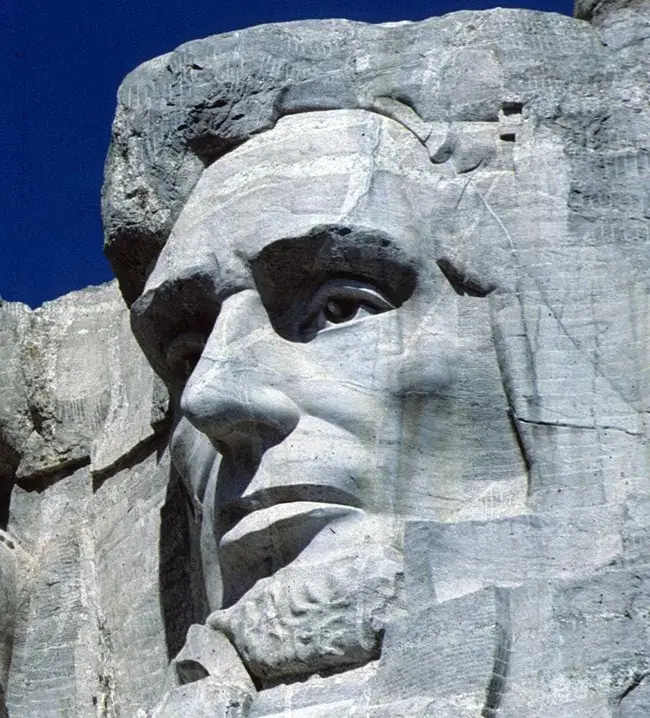
Abraham Lincoln (https://www.nps.gov/moru/learn/historyculture/why-these-four-presidents.htm).
Construction:
The construction of Abraham Lincoln’s face on Mount Rushmore was a remarkable feat of engineering and artistry. After completing George Washington’s head, work began on Lincoln’s likeness in 1935. The carving process was similar to that of the other presidents, involving a combination of dynamite blasting to remove large sections of granite, followed by meticulous drilling and chiseling to refine the details.
The workers, many experienced miners, faced numerous challenges, including unpredictable weather, hazardous conditions, and the project’s sheer scale. However, their dedication and skill ensured Lincoln’s face was accurately and beautifully depicted.
Dedication:
The carving of Abraham Lincoln’s face was completed in 1937 and officially dedicated on September 17th. A large crowd, including dignitaries and public members, attended the ceremony. Speeches emphasized Lincoln’s role as the “Great Emancipator” and his unwavering commitment to preserving the Union during the Civil War.
The dedication of Lincoln’s face was a momentous occasion that celebrated his enduring legacy as one of America’s greatest presidents. His inclusion on Mount Rushmore reminds him of his courage, leadership, and unwavering belief in freedom and equality.
Similarities and Differences Between Mount Rushmore Presidents
Similarities
- Leadership During Pivotal Moments:
- George Washington: Led the Continental Army during the American Revolution and established foundational government precedents as the first president.
- Thomas Jefferson: Led the country through the early years of its expansion, authoring the Declaration of Independence.
- Theodore Roosevelt: Led the country during progressive reform and modernization.
- Abraham Lincoln: Led the country during the Civil War, preserving the Union and ending slavery.
- Contributions to American Ideals:
- Washington and Jefferson: Both were instrumental in the founding and early expansion of the United States, establishing democratic principles.
- Roosevelt and Lincoln: Both were pivotal in shaping modern American policies, with Roosevelt’s progressivism and Lincoln’s emphasis on human rights and equality.
- Symbolism on Mount Rushmore:
- All four presidents represent critical themes in American history: birth (Washington), growth (Jefferson), development (Roosevelt), and preservation (Lincoln).
- Influence on Future Generations:
- Each president set precedents and influenced future generations of leaders and policies in their respective areas of governance.
Differences
- Historical Contexts:
- Washington: Led during the nation’s founding and early years.
- Jefferson: Led during the nation’s expansion and faced early foreign policy challenges.
- Roosevelt: Led during the industrial and progressive era, focusing on modernization and reform.
- Lincoln: Led during the Civil War, dealing with national division and the abolition of slavery.
- Major Achievements:
- Washington: Victory in the American Revolution, establishing presidential precedents.
- Jefferson: Louisiana Purchase, authoring the Declaration of Independence.
- Roosevelt: Progressive reforms, conservation efforts, Panama Canal.
- Lincoln: Preserved the Union, Emancipation Proclamation, Gettysburg Address.
- Challenges Faced:
- Washington: Building a new nation, managing new government structures.
- Jefferson: Partisan politics, foreign conflicts with Britain and France.
- Roosevelt: Balancing progressivism with conservatism, labor disputes.
- Lincoln: Civil War, national division, and slavery.
- Personal Traits and Leadership Styles:
- Washington: Known for his leadership, integrity, and humility.
- Jefferson: Intellectual, visionary, and complex personality.
- Roosevelt: Energetic, charismatic, and reform-minded.
- Lincoln: Determined, empathetic, and resilient.
- Impact on Specific Areas:
- Washington: Set the foundation for the presidency and government.
- Jefferson: Expanded U.S. territory promoted democracy and education.
- Roosevelt: Introduced progressive reforms and conservation policies.
- Lincoln: Preserved the Union’s established principles of equality and liberty.
Summary
The Mount Rushmore presidents share commonalities in their pivotal roles in American history, their contributions to American ideals, and their lasting influence on future generations. However, they differ significantly in their historical contexts, significant achievements, the challenges they faced, their personal traits and leadership styles, and their impact on specific areas of governance and policy.
Comparison of Mount Rushmore Presidents: George Washington, Thomas Jefferson, Theodore Roosevelt, and Abraham Lincoln
| Aspect | George Washington | Thomas Jefferson | Theodore Roosevelt | Abraham Lincoln |
| Role | 1st President (1789-1797) | 3rd President (1801-1809) | 26th President (1901-1909) | 16th President (1861-1865) |
| Major Contributions | The Commander of the Continental Army established presidential precedents | Authored Declaration of Independence, Louisiana Purchase | Progressive reforms, conservation efforts, strengthened foreign policy | Led the nation during the Civil War, Emancipation Proclamation |
| Symbolism on Mount Rushmore | Birth of the United States | Growth of the United States | Development of the United States | Preservation of the United States |
| Key Achievements | Victory in the American Revolution, setting government foundations | Expanding U.S. territory, promoting democracy and education | National parks establishment, Panama Canal, antitrust regulations | Preserved the Union, ended slavery, delivered the Gettysburg Address |
| Presidential Precedents | The peaceful transfer of power, neutrality in foreign wars | Expansionism, democratic ideals, public education | Government intervention in the economy, conservation | Preservation of the Union, human rights emphasis |
| Challenges Faced | Building a new nation, managing the new government | Navigating partisan politics, conflict with Britain and France | Trust-busting, labor disputes, balancing progressivism and conservatism | Civil War, national division, slavery |
| Personal Traits | Leadership, integrity, humility | Intellectual, visionary, complex | Energetic, charismatic, reform-minded | Determination, empathy, resilience |
| Historical Legacy | Father of the Nation, foundational influence | Architect of American ideals, territorial expansion | Champion of progressivism and conservation | Savior of the Union, emancipator |
| Notable Documents | Farewell Address | Declaration of Independence, Louisiana Purchase | Square Deal, Roosevelt Corollary | Emancipation Proclamation, Gettysburg Address |
| Impact on Future Generations | Set standards for future presidents | Inspired democratic movements, territorial policies | Influenced modern presidential roles, environmental policies | Established principles of equality and liberty |
Each of these presidents contributed uniquely to the formation, growth, development, and preservation of the United States, embodying critical aspects of the nation’s history and ideals.
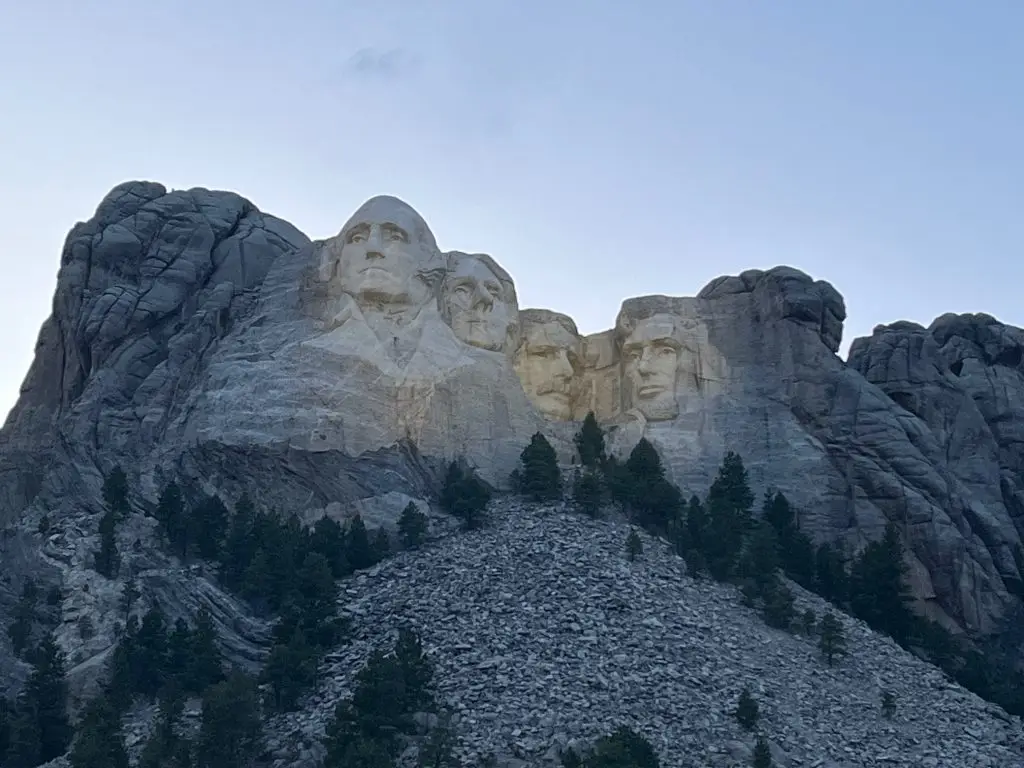
(Personal Image)
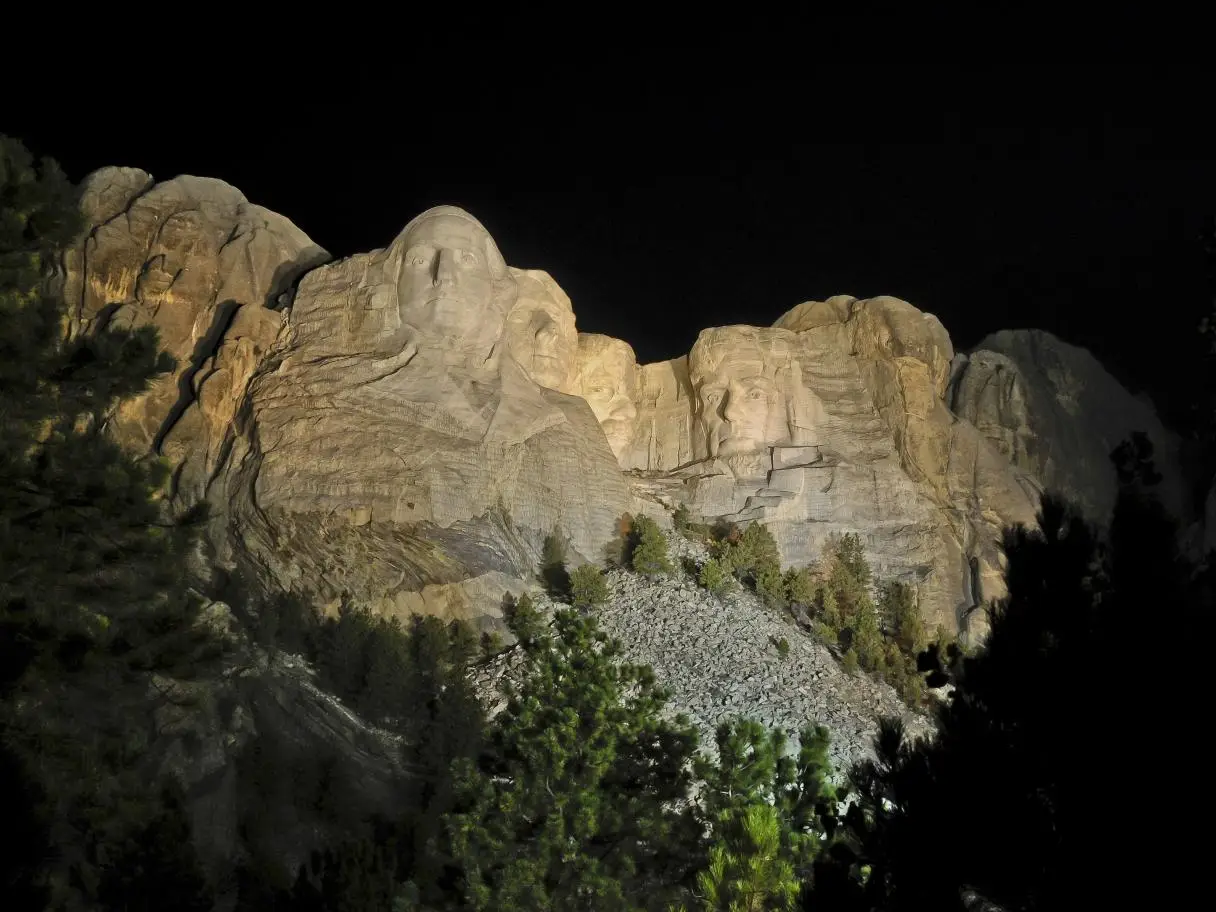
Night Mount Rushmore (www.travelsouthdakota.com Image)

